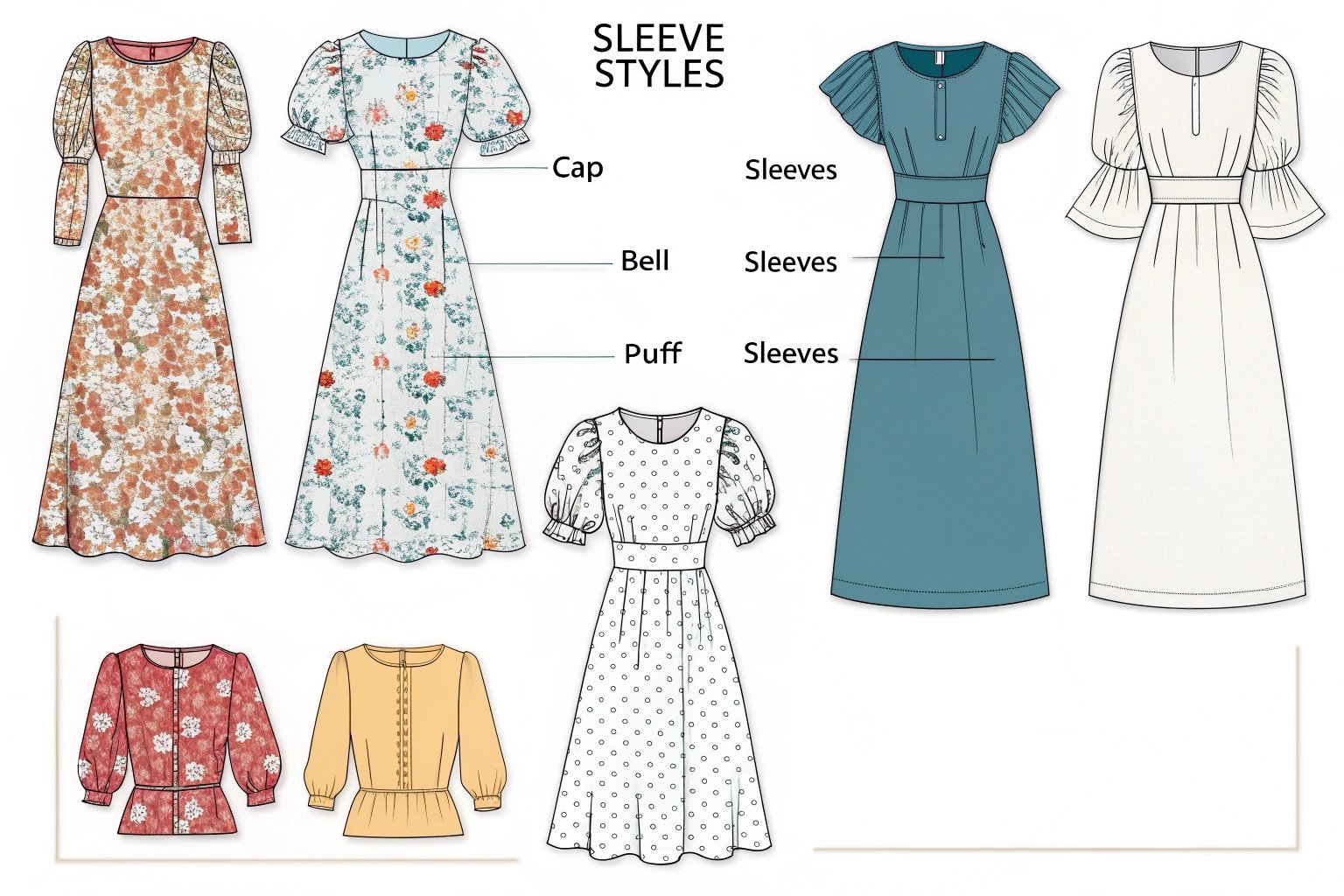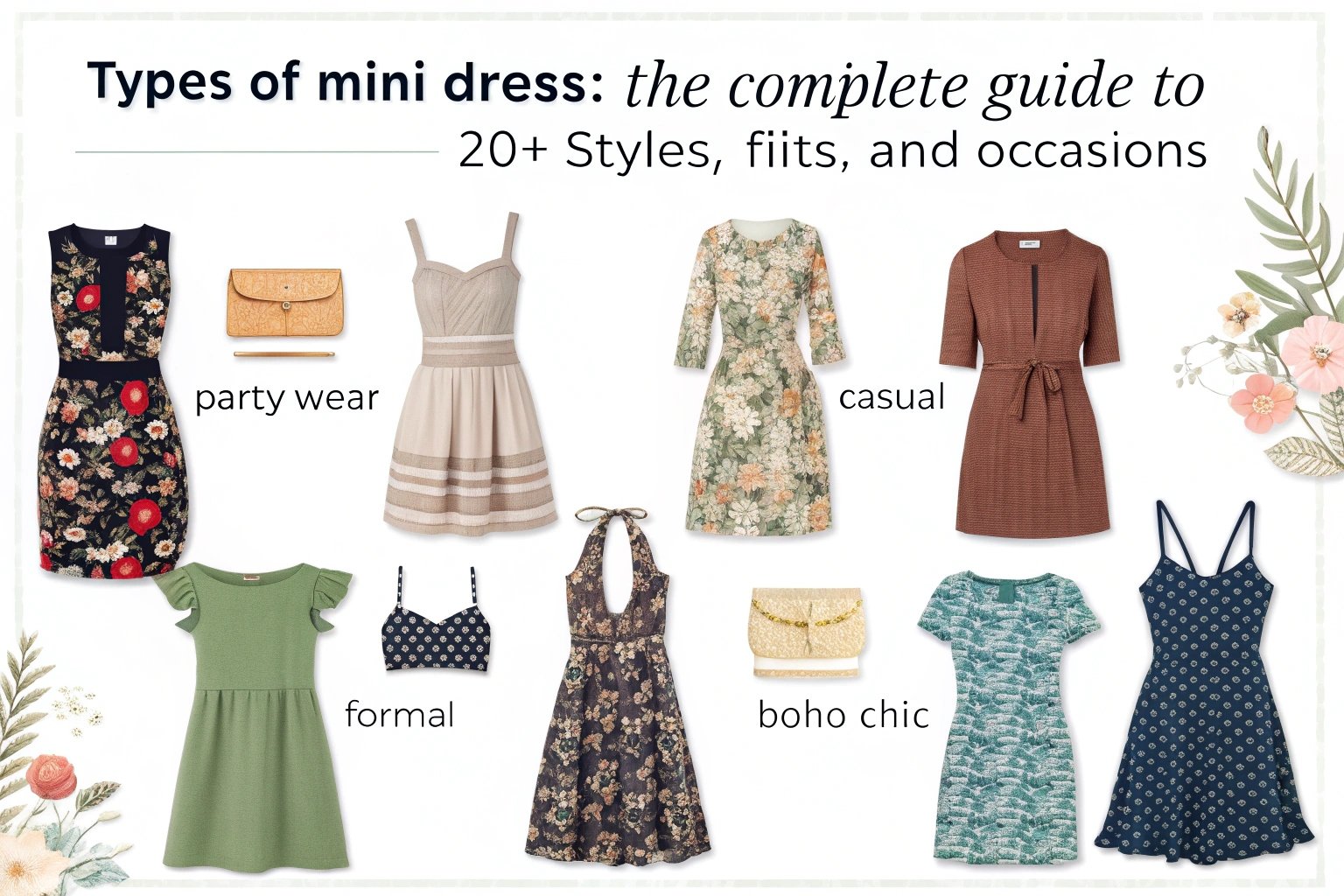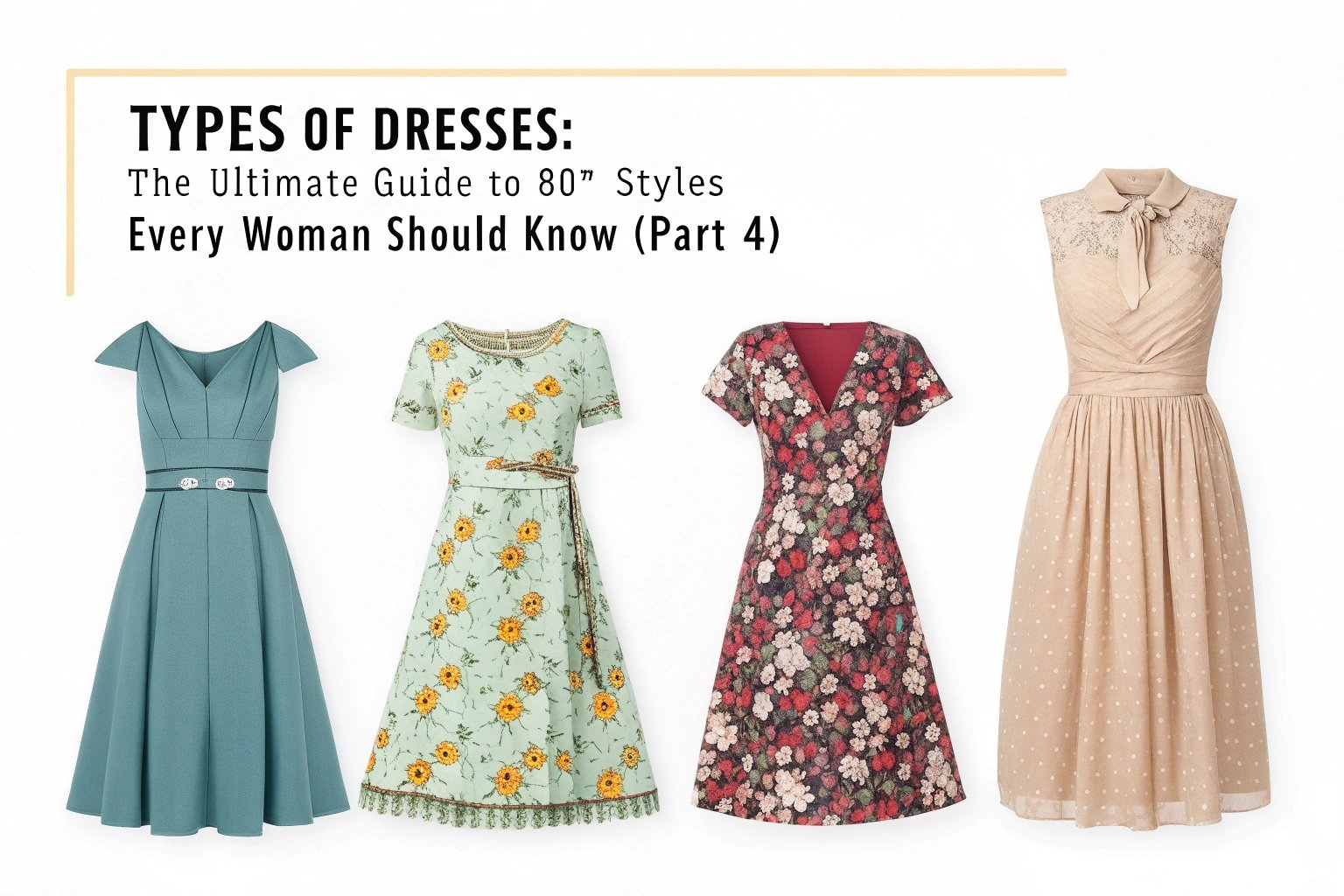In this comprehensive installment of our Types of Sleeves on Dresses series, we embark on a structured journey into the world of women’s sleeve designs. Sleeves are more than just a functional detail—they represent a dynamic blend of lengths, shapes, volume effects, cut-out designs, and fabrics that can completely transform the character of a dress.
Part 1 introduces the most essential and widely worn sleeve silhouettes, from the romantic Puff Sleeve to the elegant Bishop Sleeve. We’ll explore why these foundational styles never go out of fashion, how they flatter different body types, and the occasions where they shine the most.
- The core sleeve silhouettes every woman should recognize
- How each design balances comfort, seasonality, and visual impact
- Practical styling notes to help you integrate these sleeves into modern outfits
Sleeveless dress
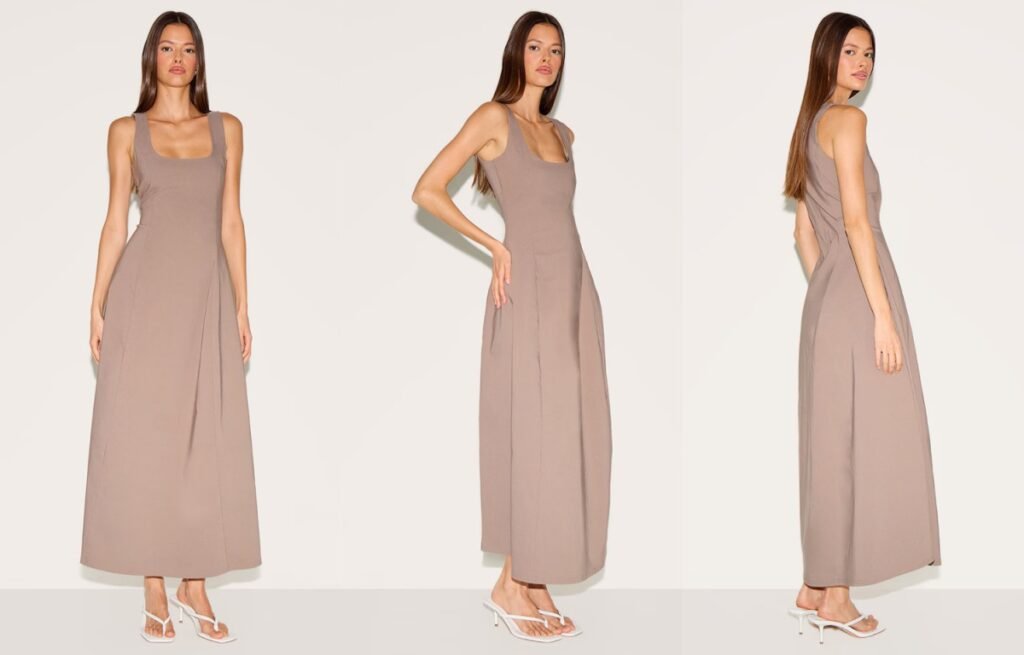
Sleeveless Dresses: Simple, Versatile, and Always in Style
The sleeveless dress is one of the most enduring and universally loved dress styles, known for its clean lines and timeless appeal.
A sleeveless dress is designed without sleeves, exposing the arms and shoulders. It offers comfort, ease of movement, and year-round styling potential. From summer wear to formal evening looks, it adapts to almost any fashion scenario.
What makes sleeveless dresses so timeless?
Their strength lies in simplicity. The lack of sleeves gives the dress a lightweight feel and a modern, minimal silhouette.
Sleeveless dresses offer a flattering, streamlined shape that works across ages, body types, and seasons. They’re easy to wear alone in warm weather or layered under jackets in cooler months.
Understanding the Design, Fit, and Function of Sleeveless Dresses
The Anatomy of a Sleeveless Cut
Sleeveless doesn’t mean shapeless. The armhole design, shoulder width, and neckline all influence how flattering and functional the dress feels.
- Wide shoulder cuts create a strong, structured look and offer bra coverage.
- Narrow straps add a delicate, feminine feel and highlight the collarbones.
- Racerback cuts give a sporty, activewear edge.
- Cap-style sleeveless options provide minimal coverage over the shoulder while maintaining a sleeveless feel.
Choosing the right cut is crucial for both comfort and style.
Who Does the Sleeveless Dress Flatter?
Sleeveless dresses are surprisingly inclusive when well-designed. Here’s how they adapt:
- Petite women: Sleeveless cuts elongate the arms and upper body.
- Athletic builds: They enhance muscle tone and define the shoulder line.
- Fuller arms or bust: Opting for wider straps or higher necklines can provide balance and comfort.
- Mature women: Sleeveless dresses with structured fabric and modest armholes offer a polished and elegant look.
The key is proportion. When the cut around the shoulder is clean and well-fitted, it enhances rather than exposes.
Fabric & Fit Considerations
Because sleeveless dresses expose more skin, fabric and structure matter more. The wrong choice can easily highlight imperfections or feel flimsy.
- Structured weaves like cotton poplin or ponte knit offer shape and support.
- Fluid fabrics like silk or rayon create soft drape and movement.
- Lined versions prevent gaping and add refinement, especially in tailored styles.
For professional wear, I always recommend thicker fabrics with defined seams. For summer dresses, breathable and lightweight materials keep the look easy and breezy.
Sleeveless vs. Other Minimal Sleeves
| Style | Arm Coverage | Look & Feel | Best For |
|---|---|---|---|
| Sleeveless | Full exposure | Classic, flexible | All seasons, layering |
| Spaghetti Strap | Very minimal | Delicate, romantic | Summer, evening wear |
| Cap Sleeve | Minimal coverage | Feminine, soft | Modest styles, daywear |
| Strapless | No support | Bold, elegant | Parties, statement occasions |
Layering Potential
Sleeveless dresses work well as a base for layering:
- Under blazers: Ideal for office looks.
- With cardigans: Adds softness and texture.
- Over shirts: For a modern, fashion-forward twist.
- With scarves or statement jewelry: To draw focus to the neckline and shoulders.
This versatility makes sleeveless dresses a smart staple for capsule wardrobes.
Best Occasions for Sleeveless Dresses
- Office: Pair structured styles with a blazer.
- Summer casual: Choose cotton or linen for comfort and breathability.
- Evening events: Opt for satin or crepe with a statement necklace.
- Layered looks: Use as a base under outerwear during transitional seasons.
Cap Sleeve dress
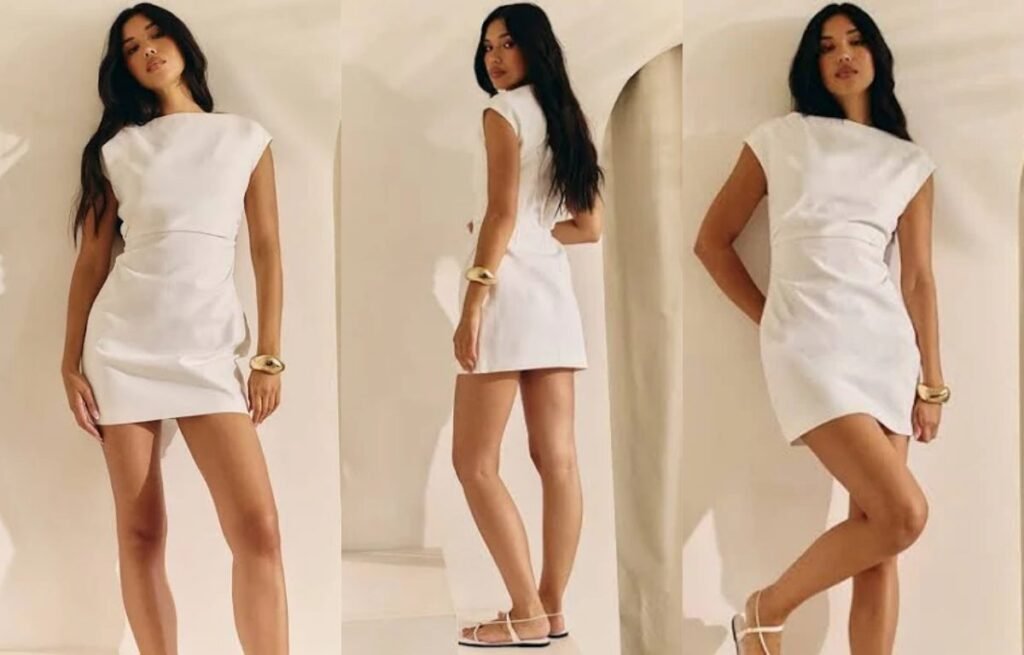
Cap Sleeve: Small in Size, Big in Impact
The cap sleeve is one of the most subtle sleeve styles, but it carries a major influence on the overall silhouette of a dress.
A cap sleeve is a short sleeve that just covers the top of the shoulder without extending down the arm. It’s often curved and set in a way that softens the shoulder line, offering a delicate, minimal finish to the garment.
Why are cap sleeves so universally flattering?
They’re barely there—but they shape the dress in a very intentional way.
Cap sleeves frame the shoulders and upper arms, providing light coverage while keeping the focus on the neckline and collarbone. They flatter a wide range of body types by adding balance and proportion.
The Design Logic Behind Cap Sleeves
What Cap Sleeves Really Do for a Dress
Cap sleeves are all about subtle enhancement. They don’t distract from the rest of the outfit, but they complete the look. Unlike sleeveless designs, they soften the transition between the bodice and the arm. For many, this small detail can make a big difference in confidence and comfort.
- Balance: Cap sleeves help balance proportions, especially for women with wider hips, by visually adding width at the shoulders.
- Coverage: They provide a bit of modesty without making the garment feel overly covered.
- Structure: On structured dresses, cap sleeves sharpen the silhouette; on flowy dresses, they keep the shoulder line refined.
Cap Sleeves and Body Type Compatibility
Cap sleeves can work for most body types, but they have specific advantages depending on how they’re designed:
- Petite frames: The small sleeve size won’t overwhelm the body, and helps maintain a clean vertical line.
- Pear shapes: Cap sleeves broaden the top slightly, balancing wider hips.
- Athletic builds: A curved cap sleeve adds softness to a straight or angular frame.
- Fuller arms: While cap sleeves don’t hide the arms, certain styles with added length or flare can offer comfort without bulk.
Styling Across Occasions and Seasons
Cap sleeves are often associated with warm-weather dresses, but they also work year-round depending on fabric and styling:
- Summer: Lightweight cotton or jersey cap sleeve dresses offer breathability and a polished finish.
- Office wear: Cap sleeves on tailored shift dresses give a professional look without the bulk of full sleeves.
- Evening wear: Lace or beaded cap sleeves add elegance without covering up a detailed bodice.
- Layering: Cap sleeve dresses are ideal for pairing with cardigans or jackets without bunching at the shoulder.
Cap Sleeves vs. Other Short Sleeves
| Sleeve Type | Coverage | Visual Impact | Best Use Case |
|---|---|---|---|
| Cap Sleeve | Just the shoulder | Delicate, balanced | All seasons, layering |
| Short Sleeve | Upper arm | Casual, versatile | Everyday wear |
| Flutter Sleeve | Loose, flowy upper arm | Romantic, soft | Boho, summer outfits |
| Sleeveless | No coverage | Sleek, minimal | Hot weather, formal base |
Best Fabrics for Cap Sleeve Dresses
Cap sleeves perform best with fabrics that match the dress’s structure:
- Cotton blends: Ideal for casual and office styles.
- Chiffon or georgette: Creates a delicate drape for romantic looks.
- Lace or mesh: Adds texture without bulk, perfect for bridal or eveningwear.
- Structured knits: Hold the cap sleeve shape for fitted, modern silhouettes.
Styling Tips for Cap Sleeve Dresses
- Necklaces: Pair with statement or layered necklaces to complement the open neckline.
- Outerwear: Ideal for blazers and coats—no extra bulk at the arms.
- Occasions: From weddings to workdays, the cap sleeve fits almost every setting with minor fabric or silhouette adjustments.
Short Sleeve dress
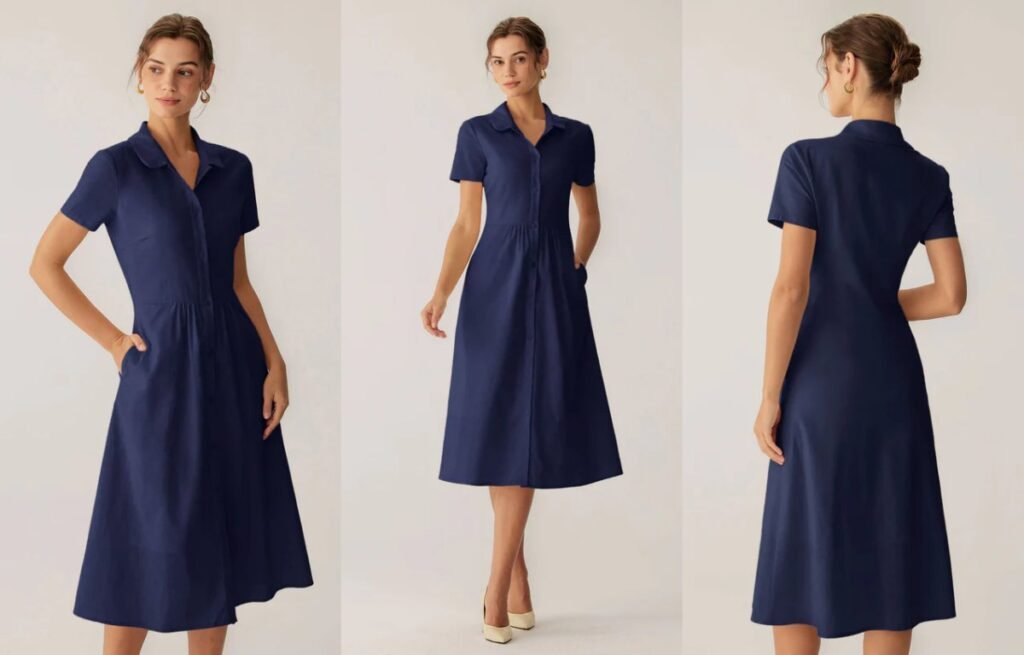
Short Sleeve: The Everyday Classic with Year-Round Appeal
The short sleeve is one of the most universally worn sleeve types, balancing comfort, coverage, and simplicity.
Short sleeves typically extend halfway between the shoulder and elbow, offering ease of movement while maintaining a clean, tailored look. This sleeve works across casual, work, and formal dresses in every season.
Why is the short sleeve such a timeless choice?
Short sleeves are everywhere, but they remain essential because of how well they work with different fabrics, fits, and body types.
They provide just enough coverage to flatter the arms while staying breathable and light, making them ideal for layering or wearing alone.
The Function, Fit, and Fashion of Short Sleeves
Universally Flattering and Functional
Short sleeves strike the perfect middle ground—not too long, not too revealing. Their length helps visually balance the upper body. They:
- Soften broad shoulders
- Add structure to sloped ones
- Offer arm coverage for those who prefer it
They’re especially useful in workwear or modest fashion, where sleeveless options might not be preferred.
Variety Within the Category
Not all short sleeves are the same. Subtle changes in length, shape, and cut can create dramatically different looks:
- Fitted short sleeve: Follows the arm closely for a sleek profile.
- Flutter short sleeve: Adds movement and softness, often cut on the bias.
- Cap short sleeve: Shorter than standard, barely covers the shoulder.
- Cuffed short sleeve: Adds visual weight and structure with a folded hem.
Each variation can change the overall tone of the dress—from playful to polished.
Styling and Seasonality
While often associated with spring and summer, short sleeves work year-round:
- Layered under blazers/cardigans: Clean shoulder lines make it easy to pair.
- With tights and boots: A short sleeve dress transitions easily into fall.
- As part of a two-piece set: Short sleeve tops and matching skirts or shorts offer seasonal flexibility.
Short sleeves are also travel-friendly—lightweight, adaptable, and wrinkle-resistant when done in knits or blends.
Short Sleeve vs. Other Lengths
| Sleeve Type | Coverage | Best For | Season |
|---|---|---|---|
| Short Sleeve | Mid-upper arm | All body types | All seasons |
| Sleeveless | No coverage | Warm climates, layering | Summer/Spring |
| Elbow Sleeve | Mid-arm | Modest looks, layering | Fall/Winter |
| Long Sleeve | Full arm | Cooler weather, formalwear | Fall/Winter |
Best Fabrics for Short Sleeves on Dresses
Fabric affects how short sleeves fall and feel. Recommended options include:
- Cotton and cotton blends: Ideal for casual, breathable daywear.
- Rayon/Modal: Soft drape for more relaxed or flowy silhouettes.
- Linen: Crisp and airy, great for summer dresses.
- Structured knits or ponte: Work well in fitted office dresses or uniforms.
Styling Tips for Short Sleeve Dresses
- For minimal looks, pair with delicate jewelry and flat shoes.
- Dress it up with heels, a belt, and bold accessories.
- In cooler months, add tights, boots, and a trench or oversized coat.
Half Sleeve dress
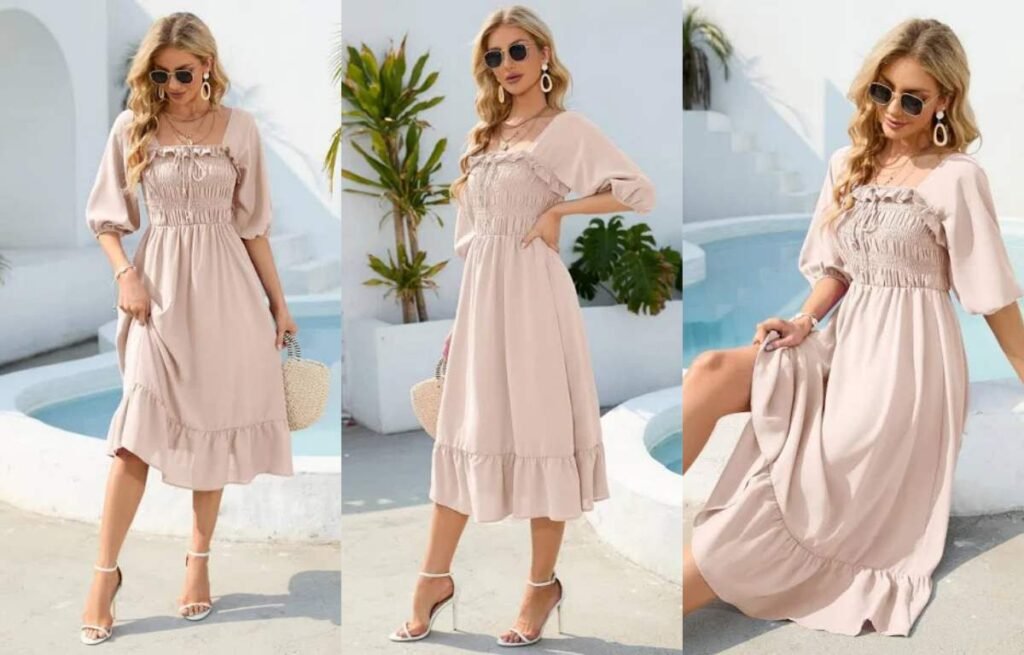
Half Sleeve: The Most Balanced and Understated Sleeve Style
The half sleeve is a timeless choice that strikes the perfect balance between coverage and breathability.
A half sleeve extends halfway between the shoulder and elbow, offering moderate coverage while keeping the arm visually elongated and slim. It works across all dress types, from casual cotton styles to tailored formal pieces.
Why is the half sleeve so versatile in women’s dress design?
This sleeve works for nearly every season, setting, and body type. It’s classic without being boring.
The half sleeve gives just enough coverage to flatter the upper arm without looking heavy, making it a go-to for both comfort and elegance. It transitions easily from office to evening, from spring to fall.
The Design Power of the Half Sleeve
Subtle Shaping Without Bulk
Unlike short sleeves, which sometimes cut the arm at an awkward spot, the half sleeve visually elongates the upper arm. It creates a cleaner, more intentional silhouette.
- For fuller arms, the longer length offers subtle coverage without clinging.
- For slimmer frames, it provides enough visual weight to balance proportions.
This makes it an ideal choice for both fitted and flowy dress silhouettes.
Seasonless and Adaptable
The half sleeve is naturally transitional. It covers enough for cooler days, yet it’s breathable in warm months. Designers love it because:
- It doesn’t require lining or insulation.
- It pairs well with layering pieces like blazers or cardigans.
- It adds structure without overpowering a dress design.
You’ll find it equally in spring dresses, autumn shifts, or even as part of a minimalist summer look.
Works Across Formality Levels
Half sleeves are incredibly flexible in terms of occasion:
- Casual: In cotton or jersey fabrics, it’s effortless and practical.
- Workwear: Offers a polished and professional touch when paired with a sheath or midi dress.
- Evening: In satin or crepe, it adds elegance without the drama of full-length sleeves.
Whether in a wrap dress, a-line, or a structured sheath, the sleeve feels intentional and stylish.
Half Sleeve vs. Other Sleeve Lengths
| Sleeve Type | Coverage Level | Vibe | Best For |
|---|---|---|---|
| Half Sleeve | Medium | Classic, balanced | All seasons, all body types |
| Short Sleeve | Low | Youthful, casual | Warm weather, casual wear |
| 3/4 Sleeve | Medium-High | Polished, modest | Office wear, layered outfits |
| Long Sleeve | Full | Elegant, formal | Cooler weather, evening looks |
Best Fabrics for Half Sleeves
Fabric choice defines how the sleeve looks and feels:
- Cotton blends: Casual comfort and breathability.
- Stretch jersey: Great for fitted dresses and flexible movement.
- Satin or crepe: For more formal or tailored pieces.
- Lace or chiffon overlays: Add detail and softness without adding weight.
Styling Tips for Half Sleeve Dresses
- Use belts or structured waists to emphasize the silhouette when the sleeve adds volume.
- For accessories, try bracelets or statement rings to balance out the covered upper arm.
- Shoes and bags can push the look casual or polished depending on the sleeve’s fabric.
Elbow Sleeve dress
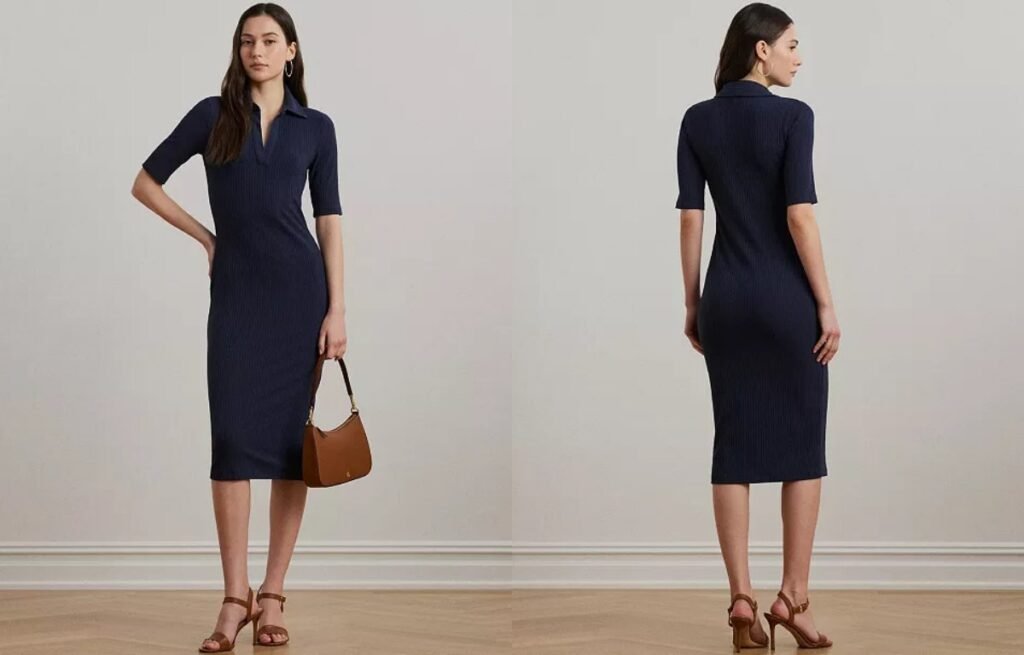
Elbow Sleeve: The Perfect Balance of Coverage and Ease
The elbow sleeve hits right at or just above the elbow, offering a balance between short and long sleeves—ideal for transitional weather and modest yet stylish looks.
Elbow sleeves provide more coverage than short sleeves but remain breathable and flattering, making them perfect for both casual and refined dress designs.
Why are elbow sleeves so versatile?
This sleeve length works across seasons, dress types, and body shapes—making it a go-to design for many designers and brands.
Elbow sleeves give structure to the upper arm while leaving enough room for comfort and style variation. They suit formal, casual, and professional settings, making them extremely wearable.
Function, Flattery, and Fashion Adaptability
Body-Flattering Proportions
The elbow sleeve is popular because it hits a naturally flattering point on the arm. It offers subtle arm coverage, which many women prefer, without looking too conservative.
- For fuller arms, elbow sleeves slim the upper arm and draw focus to the forearm.
- For narrow shoulders, this sleeve adds slight volume and structure.
- For tall or long-limbed figures, it creates a visually balanced silhouette.
Designers often use elbow sleeves in fitted or semi-fitted shapes to enhance the tailored feel of a dress while still keeping it comfortable.
Seasonal Flexibility
Unlike long or cap sleeves, elbow sleeves transition smoothly across seasons:
- Spring/Summer: In breathable fabrics like cotton or linen, they provide sun coverage while staying cool.
- Fall/Winter: In knits or heavier materials, they layer easily under jackets or blazers without bulk at the wrist.
This makes the elbow sleeve one of the most trans-seasonal options in dress design.
Suitable Across Dress Types
You’ll find elbow sleeves in a wide range of dress styles:
- Shift Dresses: Clean and professional for officewear
- A-Line Dresses: Balanced silhouette for daily wear
- Wrap Dresses: Adds polish to a feminine cut
- Bodycon Dresses: Creates a sleek, streamlined shape
- Knit Dresses: Adds warmth without full-length bulk
Comparison with Other Sleeve Lengths
| Sleeve Type | Coverage | Best For | Vibe |
|---|---|---|---|
| Cap Sleeve | Minimal | Summer, petite frames | Casual, light |
| Elbow Sleeve | Mid-upper arm | All body types, multi-season | Polished, balanced |
| 3/4 Sleeve | Below elbow | Cooler weather, layering | Classic, elegant |
| Long Sleeve | Full arm | Formal, cold weather | Professional, warm |
Best Fabrics for Elbow Sleeves
Fabric affects how structured or relaxed an elbow sleeve looks:
- Cotton blends: Great for everyday or office wear—breathable and crisp.
- Knits: Add stretch and comfort for fitted designs or casual dresses.
- Linen: Perfect for summer elbow-sleeve dresses with a relaxed feel.
- Silk or Satin: Ideal for formal dresses with a soft drape and sheen.
- Ponte or Double-Knit: Structured yet stretchy, perfect for tailored silhouettes.
Styling Tips for Elbow Sleeve Dresses
- Use a belt to emphasize waist definition in looser fits.
- Keep accessories minimal for professional looks or add bold earrings for a casual-chic style.
- Elbow sleeves pair perfectly with wrist accessories—bracelets or watches won’t be hidden.
Three-Quarter Sleeve dress
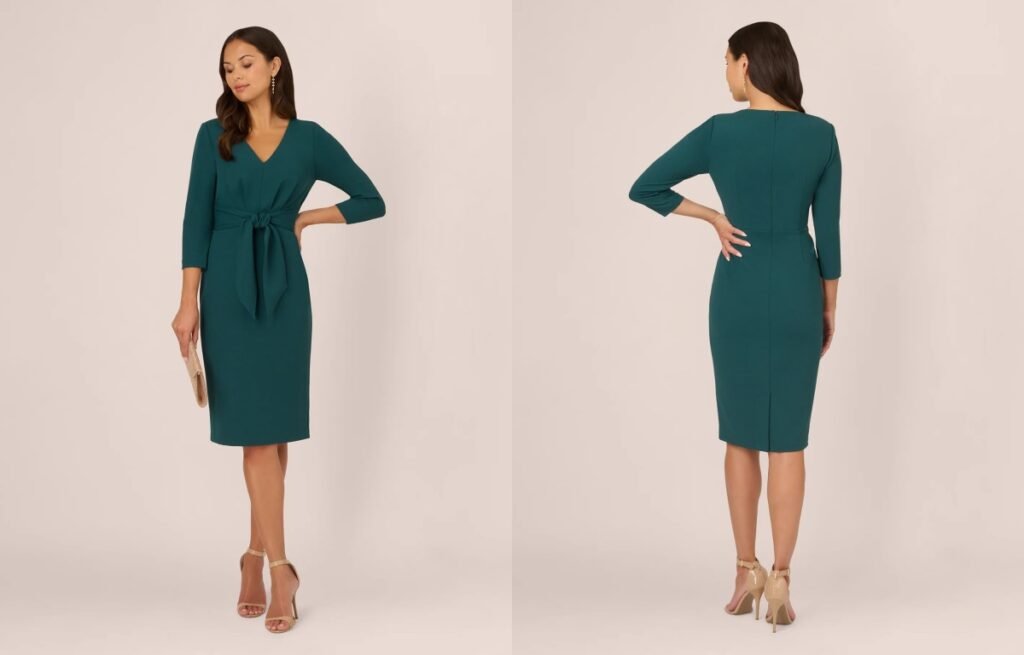
Three-Quarter Sleeve: The Perfect Balance Between Style and Function
The three-quarter sleeve is one of the most versatile and universally flattering sleeve lengths in women’s fashion.
Ending between the elbow and wrist, this sleeve offers enough coverage for cooler seasons while keeping the arms visually elongated and lightweight. It works seamlessly across casual, office, and formal wear.
Why is the Three-Quarter Sleeve So Popular Across Seasons?
This sleeve hits the sweet spot—not too short, not too long—making it a reliable go-to in both transitional and layered outfits.
Three-quarter sleeves offer elegance, coverage, and comfort, without the heaviness of full-length sleeves. It’s ideal for dressing up or down, depending on fabric and cut.
What Makes Three-Quarter Sleeves So Universally Effective?
Visually Slimming and Flattering
Three-quarter sleeves naturally draw the eye to the waistline, helping define the upper body and create a balanced silhouette. This makes them especially flattering for:
- Petite frames: The shorter sleeve prevents the arms from looking overwhelmed by fabric.
- Fuller arms: Offers subtle coverage without adding bulk.
- Mature women: Provides modesty while maintaining a chic appearance.
The sleeve length also exposes the slimmest part of the arm—just below the elbow—adding to its slimming effect.
All-Season Adaptability
Unlike many sleeves that are tied to one season, the three-quarter sleeve works year-round:
- Spring/Fall: Perfect on its own in mild temperatures.
- Winter: Easily layered under cardigans, jackets, or coats.
- Summer: Works in air-conditioned settings or with breathable fabrics like cotton and rayon.
Designers often use this sleeve to add practicality without compromising style, especially in workwear and day-to-night outfits.
Professional Without Being Conservative
Three-quarter sleeves are a favorite in office wear because they feel tailored and appropriate without being too covered. They pair well with pencil skirts, trousers, or sheath dresses—especially when you want to keep your arms partially covered but maintain movement and comfort.
Styling Benefits
- Jewelry-friendly: Leaves space for bracelets and watches to be visible.
- Layering: Fits smoothly under blazers without bunching at the wrist.
- Form and function: Doesn’t interfere with tasks like typing or writing, making it ideal for work.
Three-Quarter Sleeve vs. Other Sleeve Lengths
| Sleeve Type | Coverage | Best For | Key Benefit |
|---|---|---|---|
| Three-Quarter Sleeve | Mid-forearm | Office, casual, formal wear | Versatile and flattering |
| Full Sleeve | Wrist-length | Cold seasons, formal looks | Warm and classic |
| Short Sleeve | Upper arm | Summer, casual | Light and relaxed |
| Elbow Sleeve | Ends at elbow | Retro styles, petite frames | Structured and stylish |
Best Dress Styles and Fabrics for Three-Quarter Sleeves
- Sheath Dresses: Clean lines + fitted sleeve = modern professional look.
- Fit-and-Flare: Adds balance with structured volume in the skirt.
- Wrap Dresses: The sleeve pairs well with the flow of a wrap style.
- Fabrics: Cotton blends, ponte, crepe, jersey, and even lace offer great results depending on occasion.
Bracelet Sleeve dress
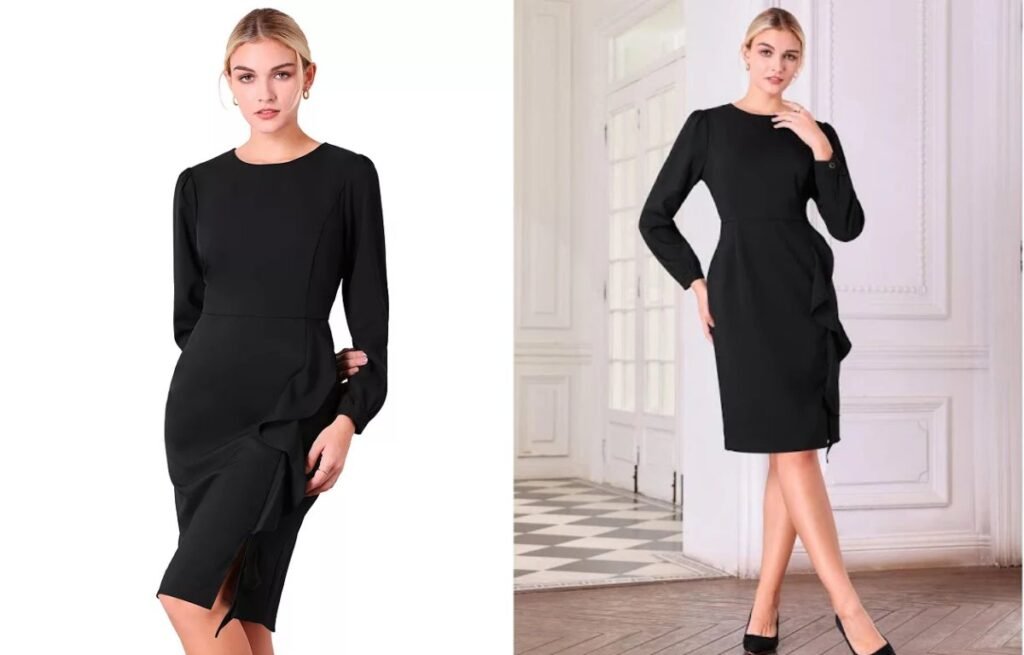
Bracelet Sleeve: Understated Elegance with a Modern Twist
The bracelet sleeve is a chic, subtle sleeve style that ends just above the wrist, allowing bracelets or watches to be seen.
Characterized by its slightly shorter-than-full length, the bracelet sleeve offers elegance without excess, balancing coverage with a tailored, modern feel. It’s ideal for both formal and everyday styles.
Why is the bracelet sleeve a versatile choice in dress design?
This sleeve feels intentional—refined without being overly dramatic.
Its cropped length draws attention to the wrist, making it perfect for showcasing jewelry while adding a polished finish to dresses. The silhouette works across seasons and body types, offering coverage without bulk.
Function, Fit, and Fashion Impact
1. Practicality Meets Design
The bracelet sleeve hits at that ideal spot—just short of the wrist bone—keeping the arms covered while staying out of the way. This makes it especially functional for everyday wear:
- No interference: The shorter length avoids getting caught while writing, typing, or handling tasks.
- Layer-friendly: Works well under coats and jackets without bunching at the cuff.
- Office-ready: A smart option for professional settings where full sleeves might feel too heavy.
2. Visual Balance and Proportion
The bracelet sleeve helps balance proportions by visually lifting the focus upward from the hands to the mid-arm. It creates a lightness around the lower arms, especially when paired with:
- A cinched waist
- A flowy skirt
- A clean neckline
This balance is especially helpful for women with shorter arms or a petite frame, as it avoids overwhelming their proportions.
3. Styling Opportunities
Because the wrist is exposed, bracelet sleeves invite accessories:
- Statement bangles or stacked bracelets feel intentional and visible.
- Watches become part of the outfit’s design.
- Cuffs or sleeve ruffles can be added to make the sleeve itself a highlight.
The look also transitions well between seasons. In spring, it pairs with lighter fabrics. In fall, it balances heavier materials like tweed or wool without adding bulk.
4. Design Compatibility
Bracelet sleeves work across many dress silhouettes:
- A-line dresses: Keep the focus on the waist and wrist.
- Sheath dresses: Emphasize clean, professional lines.
- Wrap dresses: Add structure to an otherwise soft shape.
- Midi dresses: Maintain balance between hemline and sleeve length.
Bracelet Sleeve vs. Other Long Sleeve Styles
| Sleeve Type | Length | Best For | Overall Vibe |
|---|---|---|---|
| Bracelet Sleeve | Just above the wrist | Office, casual elegance | Clean, refined |
| Full-Length Sleeve | Covers entire wrist | Formal and cold-weather wear | Classic, traditional |
| Three-Quarter | Mid-forearm | Everyday, relaxed looks | Effortless, light |
| Bishop Sleeve | Tapered at wrist | Romantic, boho styles | Dramatic, flowy |
Best Fabrics and Seasonal Use
Fabric choice changes how bracelet sleeves feel:
- Cotton poplin: Crisp and clean for warm seasons
- Wool blends: Structured and warm for autumn/winter
- Silk and satin: Ideal for dressier events
- Crepe and ponte knit: Perfect for office dresses with movement and hold
In summer, opt for lightweight bracelet sleeves that feel like air. In colder months, structured bracelet sleeves give room for gloves or layering with long coats.
Styling Tips
- Match the sleeve with visible bracelets, watches, or cuffs.
- Choose slim or slightly flared sleeves depending on the formality of the dress.
- Layer with cropped jackets to highlight the sleeve detail.
Long Sleeve dress
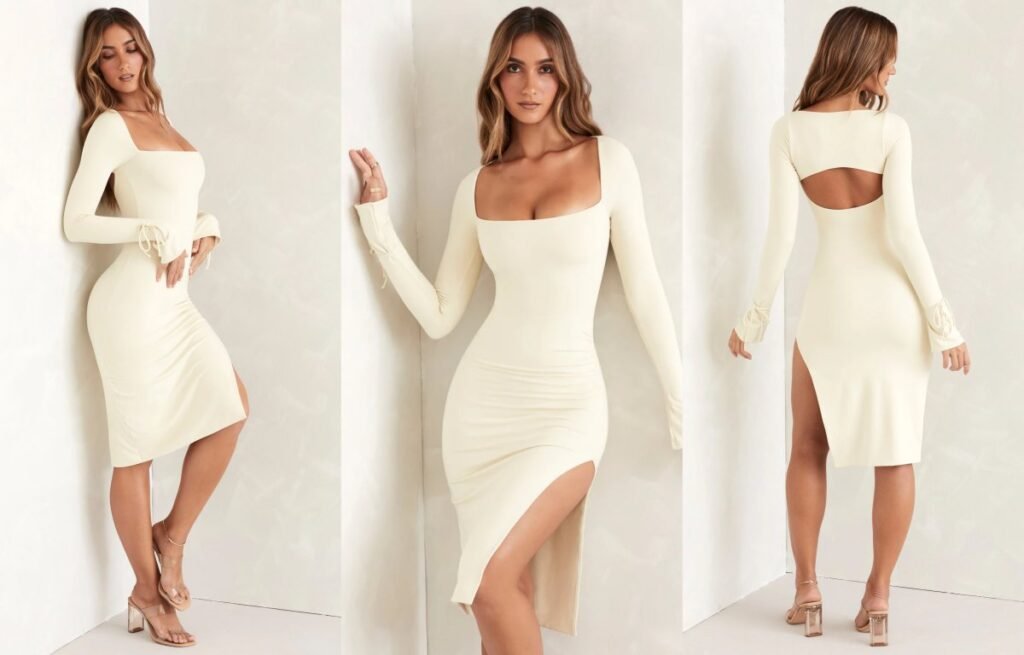
Long Sleeve: A Classic That Never Goes Out of Style
The long sleeve is the most versatile and timeless sleeve type in dress design. From formal wear to cozy knits, it adapts to every season and occasion.
Long sleeves extend from shoulder to wrist, offering coverage, warmth, and a clean, elongated silhouette. They’re often the foundation for endless sleeve variations like bishop, balloon, puff, or flared styles.
Why are long sleeves essential in dress design?
They do more than just cover arms—they shape the entire look.
Long sleeves create a sleek, balanced proportion, frame the upper body, and make any outfit look more refined. They also allow greater flexibility for seasonal styling.
The Functional and Visual Power of Long Sleeves
Elegance Through Simplicity
Long sleeves are often associated with formality and sophistication. Whether slim-fitted or flowing, they immediately elevate the mood of a dress. A basic silhouette can look premium with the right sleeve—long sleeves subtly signal grace and poise.
- In evening wear, they add drama and modesty.
- In office looks, they communicate professionalism.
- In casual styles, they provide comfort and ease.
Year-Round Practicality
Long sleeves are a smart choice across seasons:
- Fall/Winter: Offer warmth with wool, jersey, or velvet.
- Spring: Light cotton or mesh long sleeves give sun coverage without overheating.
- Summer evenings: Sheer or lace long sleeves add polish without bulk.
This makes them ideal for transitional pieces and layered looks.
Enhancing Body Balance
Long sleeves visually lengthen the arms and streamline the torso. They:
- Minimize attention on the upper arms
- Balance out fuller skirts or voluminous silhouettes
- Create a clean frame for printed or embellished dresses
For clients who want a slimming, elongating effect, long sleeves are always among my top suggestions.
Adaptability Through Style Variations
The beauty of the long sleeve lies in how many ways it can evolve:
- Fitted long sleeve: Clean, modern, and minimal.
- Bishop sleeve: Adds volume at the cuff, great for soft movement.
- Flared or bell sleeve: Adds a touch of drama or bohemian flair.
- Ruched or shirred sleeve: Introduces texture while maintaining coverage.
- Layered long sleeve: Combines sheer underlayers with structural elements for a fashion-forward look.
Designers use long sleeves as a canvas—sometimes it’s not about the sleeve itself, but what it allows you to do with the rest of the garment.
Long Sleeves vs. Other Sleeve Lengths
| Sleeve Type | Coverage | Best Season | Styling Vibe |
|---|---|---|---|
| Long Sleeve | Full arm | All seasons | Elegant, versatile |
| Short Sleeve | Upper arm | Spring/Summer | Casual, light |
| 3/4 Sleeve | Mid forearm | Transitional | Balanced, practical |
| Sleeveless | None | Summer | Bold, breathable |
Best Fabrics for Long Sleeve Dresses
Fabric changes the feel of a long sleeve:
- Jersey/Knits: Everyday comfort and stretch.
- Cotton Poplin: Crisp and clean for structured styles.
- Lace/Mesh: Romantic, breathable, and perfect for layering.
- Chiffon/Georgette: Light and airy with subtle movement.
- Satin/Silk: Glossy and fluid for evening looks.
Styling Tips for Long Sleeve Dresses
- Roll or ruche them for a casual twist.
- Pair with statement earrings to keep the look balanced.
- Use belts to break up long sleeves in solid-colored dresses.
- Choose contrasting fabrics (sheer sleeves with opaque bodices) for a modern look.
Extra-Long Sleeve dress
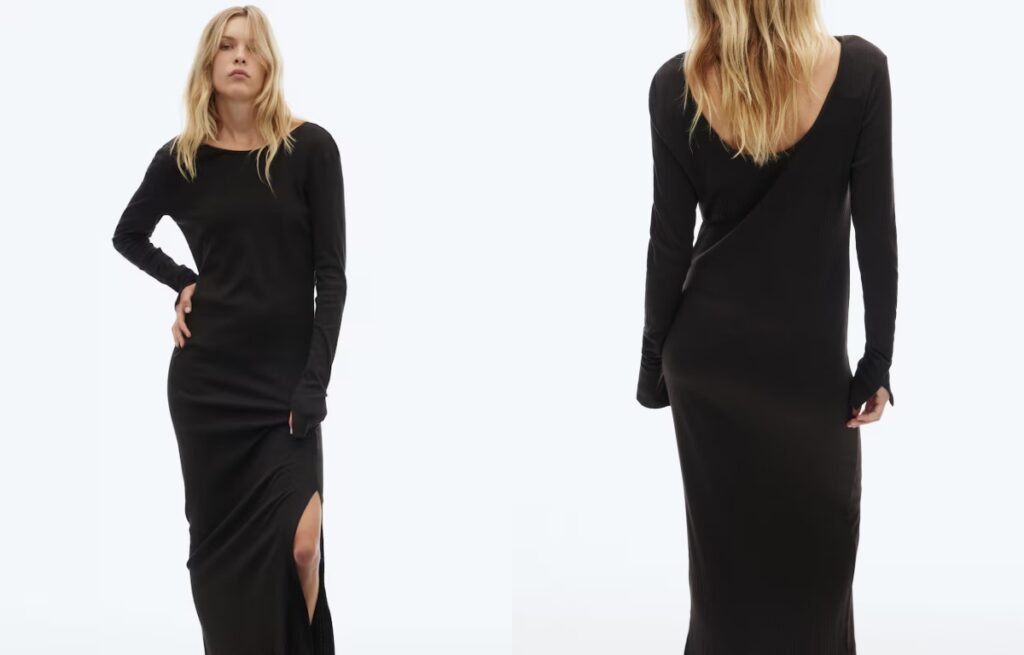
Extra-Long Sleeve: Dramatic, Stylish, and Surprisingly Practical
The extra-long sleeve stretches past the wrist—sometimes to the knuckles or even fingertips—offering a modern, slightly edgy twist on traditional sleeve lengths.
It gives the dress a relaxed, fashion-forward vibe while also offering added coverage, warmth, and style. This sleeve is popular in streetwear, minimalist fashion, and even eveningwear when done in luxe fabrics.
Why is the extra-long sleeve trending across different styles?
More than just a longer sleeve, this design shifts the entire energy of a dress.
Extra-long sleeves create a sense of drama and softness at the same time, balancing fashion with comfort. The extra length adds movement and often subtly changes the wearer’s posture or gesture.
Understanding the Impact of Extra-Long Sleeves in Fashion
Visual Elongation
Extra-long sleeves naturally elongate the arms and create a sleek, continuous line. When paired with a fitted bodice or slim silhouette, they can make the wearer appear taller and more refined.
Designers use this sleeve style to soften the shoulder line and add flow to the arms, making movements appear more graceful.
Functional Elegance
Though primarily a style detail, extra-long sleeves also serve a practical function:
- Added warmth in cooler seasons
- Coverage for the hands in transitional weather
- Protection from sun in lightweight summer dresses made from breathable materials
It’s this blend of beauty and utility that keeps them popular year-round.
Styling Variations
Extra-long sleeves can be designed in several ways:
- Fitted and extended: Clean and minimal, often seen in bodycon or ribbed dresses
- Flared at the cuff: Adds softness and drama; pairs well with flowing or bohemian styles
- Thumbhole designs: Common in active or streetwear styles
- Layered or ruched: For a gathered look that adds volume and texture
Each variation affects how the dress is perceived—sleek, romantic, or sporty.
Cultural and Editorial Influence
Extra-long sleeves have been a staple in runway and editorial fashion. They’re often used in minimalist, avant-garde, or Scandinavian-inspired collections. In streetwear, they reflect a “relaxed but intentional” mood—especially when layered or styled oversized.
The style also taps into the “quiet luxury” or “soft drama” trend, where subtle exaggerations replace loud statements.
Extra-Long vs. Other Sleeve Types
| Sleeve Type | Length | Vibe | Ideal For |
|---|---|---|---|
| Extra-Long Sleeve | Beyond wrist to hands | Modern, elegant, edgy | Transitional seasons, layering |
| Regular Long Sleeve | At wrist | Classic, balanced | Everyday wear |
| Bell Sleeve | Flared, shorter | Feminine, boho | Spring/summer looks |
| Cap Sleeve | Minimal, shoulder only | Playful, casual | Warm weather styling |
Best Fabrics for Extra-Long Sleeves
Fabric matters when the sleeve extends beyond the wrist. The wrong fabric can cause bulk or sagging. The right one enhances movement.
- Ribbed knits: Perfect for bodycon styles; stretch and structure
- Light jersey or modal: Soft, drapey sleeves with a casual finish
- Wool blends: Ideal for fall/winter dresses with extended sleeves
- Silk/satin: Creates elegant movement for formal styles
Styling Tips
- Let the sleeves be the focus—keep accessories simple.
- Push up or ruche the sleeves slightly to add texture.
- For layering, wear under sleeveless coats or short jackets to show the length.
- Avoid heavy bracelets that interfere with sleeve lines.
Fitted Sleeve dress
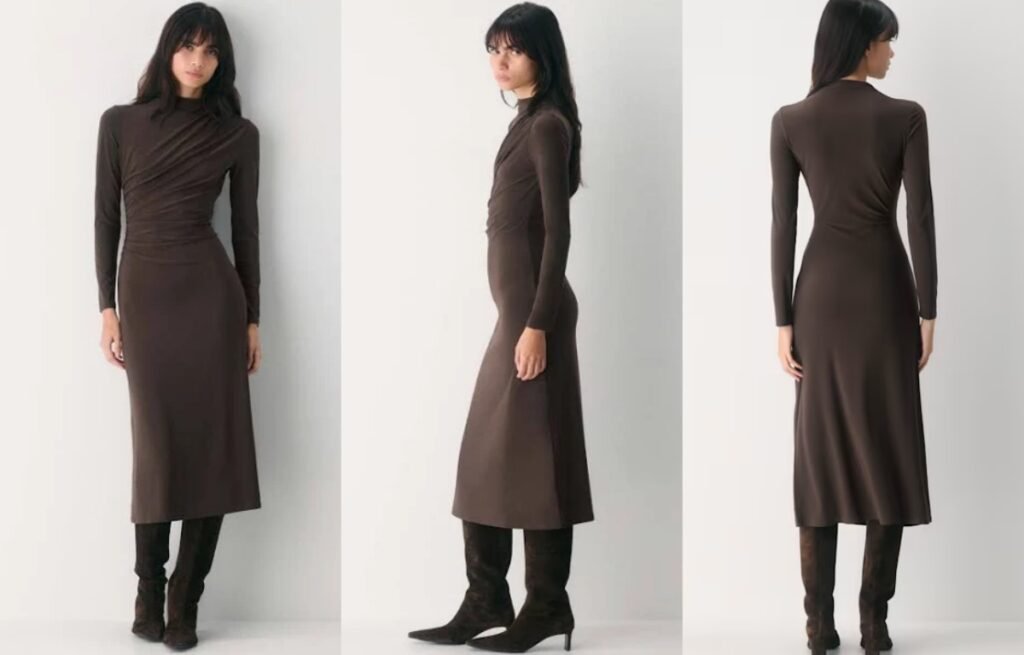
Fitted Sleeve: Clean Lines and Classic Structure
The fitted sleeve is a timeless sleeve style that contours the arm and complements almost every dress silhouette.
It’s cut close to the arm from shoulder to wrist or elbow, offering a sleek and tailored look that enhances the overall fit of a garment. Whether short, three-quarter, or full-length, fitted sleeves bring subtle elegance and structure to any dress.
What makes the fitted sleeve so essential in dress design?
The power of a fitted sleeve lies in its simplicity—it frames the body without distraction.
Fitted sleeves create clean vertical lines, elongating the arms and slimming the silhouette while maintaining a structured appearance. They work seamlessly across seasons and styles, from bodycon dresses to formal gowns.
The Purpose and Precision Behind Fitted Sleeves
Silhouette Shaping
Fitted sleeves play a key role in shaping the overall silhouette. By sitting close to the arm, they avoid bulk and let the dress’s body speak for itself. They’re especially useful when the design focus is on the bodice or waist, not the sleeve.
- For tailored dresses: Fitted sleeves complete the clean lines and support a professional look.
- For body-hugging silhouettes: They add continuity from shoulder to hem.
- For formalwear: They create balance when paired with dramatic skirts or embellishments.
Versatility Across Styles and Seasons
One of the strengths of fitted sleeves is how well they adapt:
- Short fitted sleeves: Ideal for summer, casual dresses, or minimal styles.
- Three-quarter sleeves: Offer a polished look for business or transitional weather.
- Long fitted sleeves: Perfect for eveningwear or cold-season outfits, offering warmth without bulk.
Designers also love fitted sleeves for layering—they work under coats or blazers without interfering with shape or movement.
Fabric and Fit Considerations
Because fitted sleeves hug the arm, fabric choice and pattern precision matter:
- Stretch fabrics (e.g., jersey, ponte): Ensure comfort and movement without compromising the sleeve’s slim line.
- Woven fabrics: Require exact tailoring and often need added elements like darts or zippers for ease.
- Lace or mesh: Offer a soft fitted look with visual texture, often used in bridal or formalwear.
The fit must be snug but not tight. Poor fit in a fitted sleeve can cause pulling at the elbow or restrict arm movement—issues that can break an otherwise clean design.
Styling Role in Different Looks
Fitted sleeves support different fashion directions:
| Dress Style | Role of Fitted Sleeve |
|---|---|
| Sheath Dress | Adds sleek structure |
| Wrap Dress | Balances soft draping |
| Peplum or A-Line Dress | Keeps attention on the waist |
| Evening Gown | Adds elegance without volume |
| Minimalist Styles | Enhances clean, modern lines |
They’re also excellent for showcasing accessories like:
- Statement cuffs or bracelets
- Layered outerwear
- Tailored gloves for formal looks
Best Fabric Pairings for Fitted Sleeves
To keep the sleeve looking polished:
- Cotton blends: Great for daily wear with structure and breathability.
- Jersey knits: Perfect for close-fit casual or work dresses.
- Velvet, satin, or crepe: For fitted sleeves in eveningwear.
- Lace and tulle: Common in bridal and romantic styles, offering both coverage and style.
Puff Sleeve dress
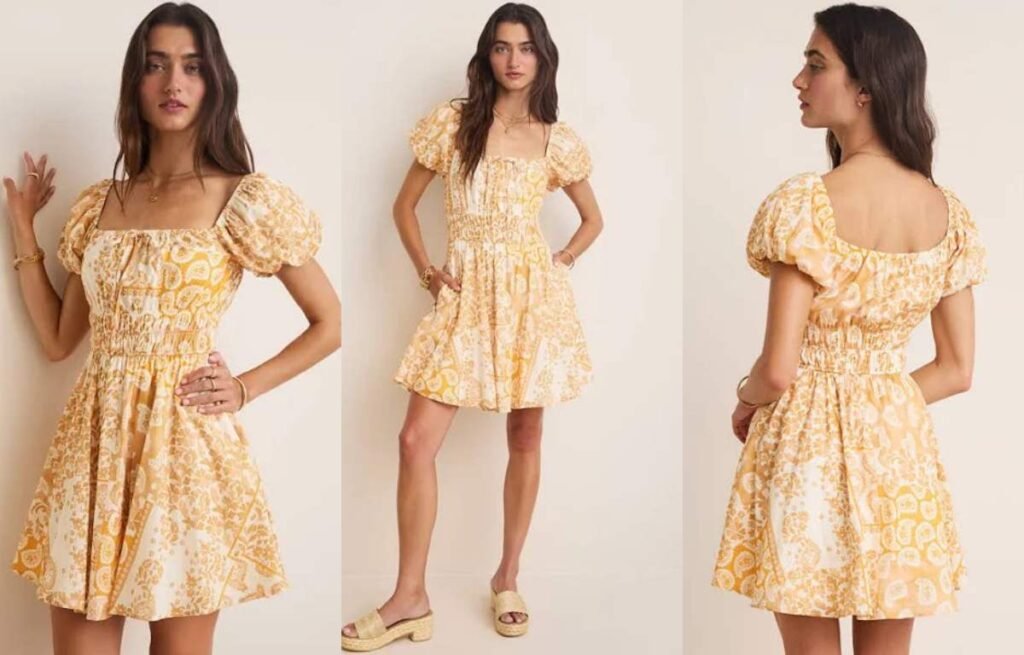
Puff Sleeve: Feminine Volume That Never Goes Out of Style
The puff sleeve is a timeless fashion detail known for adding soft volume and romantic shape to a dress.
Characterized by gathered or pleated fabric at the shoulder and sometimes at the cuff, the puff sleeve adds structure, charm, and drama to all types of dress silhouettes. It comes in endless variations—from subtle to oversized.
Why are puff sleeves so universally loved?
Puff sleeves offer a mix of nostalgia, femininity, and bold style in one simple design element.
They enhance the shoulder line, balance proportions, and add visual interest to both casual and formal dresses. Whether it’s a subtle puff or a bold balloon shape, the sleeve creates volume that elevates even the simplest silhouette.
The Design Power of Puff Sleeves
Balancing the Silhouette
One of the key roles of puff sleeves in dress design is to balance proportions:
- For pear-shaped bodies: Puff sleeves draw the eye upward and balance out wider hips.
- For rectangular shapes: They add curves and visual width to the upper body.
- For inverted triangle figures: Lighter puffs soften strong shoulders when kept subtle.
By adjusting puff size and placement, designers can sculpt how the body appears—making puff sleeves a strategic design tool, not just decoration.
Styling Range: From Subtle to Statement
There are many types of puff sleeves, each creating a different effect:
- Cap puff sleeves: Softly gathered, great for casual or romantic looks.
- Mid-length puff sleeves: Add vintage charm and elegance, often seen in 50s-inspired styles.
- Oversized puff sleeves: High drama and fashion-forward, perfect for runway or editorial looks.
- Cuffed puff sleeves: Combine volume at the top with a tailored wrist for structure.
Designers often play with volume control by choosing how much fabric to gather and where the puff begins and ends. This makes the puff sleeve adaptable to different dress styles—wrap dresses, A-lines, bodycons, even minimalist cuts.
Historical Influence and Trend Cycles
Puff sleeves have deep roots in historical fashion—from Victorian gowns to 80s power dressing. Each era reinterprets them differently:
- Victorian era: Full and formal, often exaggerated.
- 1980s: Sharp, structured puffs as symbols of power.
- 2020s: Romantic, playful, and reimagined in natural fabrics like cotton and linen.
Their cyclical return to trend shows their emotional appeal—puff sleeves feel nostalgic yet modern when styled right.
Puff Sleeve vs. Other Voluminous Sleeves
| Sleeve Type | Key Feature | Style Impact | Best Use Case |
|---|---|---|---|
| Puff Sleeve | Gathered volume | Feminine, balanced | Casual to formal dresses |
| Bishop Sleeve | Volume to cuff | Flowing, romantic | Boho or maxi dresses |
| Balloon Sleeve | Full round shape | Bold, structured | Statement outfits |
| Bell Sleeve | Flared from elbow | Soft, vintage | Flowy or retro styles |
Best Fabrics for Puff Sleeves
Fabric affects how the sleeve holds its shape:
- Cotton poplin: Crisp and holds structure well.
- Organza: Lightweight and sheer, ideal for bold puff shapes.
- Linen: Natural, breathable, slightly structured.
- Taffeta or satin: Adds formality and sheen.
- Soft knits: For subtle, everyday puff sleeve dresses.
Styling Puff Sleeve Dresses
- Balance volume: Pair big sleeves with fitted waists or slimmer skirts.
- For bold sleeves, keep accessories minimal.
- Puff sleeves work beautifully with vintage jewelry or soft curls for a romantic vibe.
Bishop Sleeve dress
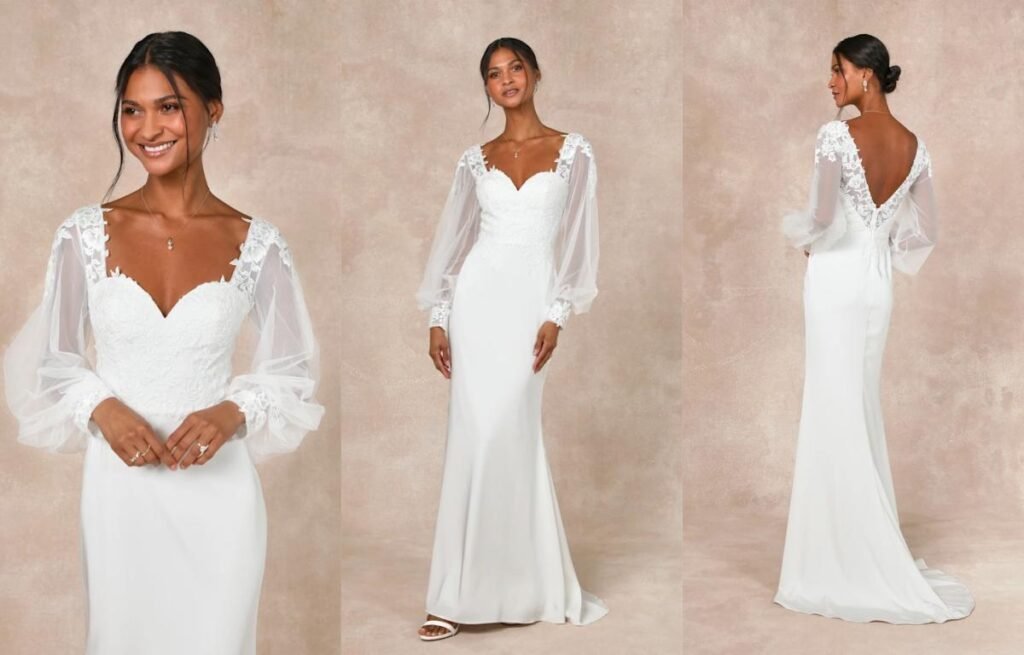
Bishop Sleeve: Romantic, Flowing, and Timeless
The bishop sleeve is a full-length, voluminous sleeve gathered at the wrist with a fitted cuff, creating an elegant drape.
This sleeve combines fullness with structure—soft at the top, tapered at the wrist—giving any dress a romantic and refined silhouette. It’s often seen in vintage-inspired looks, formal dresses, and bohemian styles.
What makes bishop sleeves so unique and versatile?
Bishop sleeves stand out because they balance volume and control in one clean silhouette.
The wide, flowing sleeve gathers into a neat cuff, allowing for dramatic movement without overwhelming the outfit. It adds texture and grace to both simple and elaborate designs.
Why Bishop Sleeves Work in Both Design and Wearability
Historical Roots with Modern Relevance
Bishop sleeves have roots in medieval and Victorian fashion, where they symbolized elegance and status. In modern fashion, they continue to deliver softness and drama, but with more wearable ease. Their ability to evoke romance makes them a go-to in bridal, evening, and high-end casual wear.
Designers today use bishop sleeves to bring classic beauty into modern shapes—blending tradition with trend.
Shape and Structure
Bishop sleeves usually start with extra width at the shoulder or upper arm. This width allows the sleeve to drape loosely and create fluid motion. As the sleeve narrows toward the wrist and gathers into a cuff, it creates contrast—a key element in balanced fashion design.
This shape is flattering because:
- It elongates the arms.
- Adds softness to structured dresses.
- Balances wide hips or fuller lower bodies by adding volume up top.
Fabric Behavior: Why Material Choice Matters
The sleeve’s beauty depends heavily on fabric choice. Soft, flowing materials highlight its elegance, while heavier fabrics give it a more dramatic, fashion-forward effect.
| Fabric Type | Effect on Sleeve | Best For |
|---|---|---|
| Chiffon | Light, airy, romantic | Boho, bridal, spring dresses |
| Silk/Georgette | Soft, fluid, upscale | Formal eveningwear |
| Tulle or Organza | Stiff, structured | Statement or couture looks |
| Cotton Voile | Lightweight, breathable | Day dresses, summer wear |
Styling Across Seasons
Bishop sleeves aren’t limited to one season. Here’s how to style them year-round:
- Spring/Summer: In lightweight fabrics, bishop sleeves add softness without heat. Perfect for floral dresses or relaxed maxi styles.
- Fall/Winter: In velvets, knits, or heavier blends, they offer warmth and volume, ideal for midi dresses, tunics, or evening gowns.
Styling Tips:
- Pair with minimal accessories—bishop sleeves are already eye-catching.
- Define the waist to avoid looking bulky—belts or fitted bodices work well.
- Wear hair up or back to keep the neckline open and draw attention to the sleeve’s shape.
- For layering, choose cropped or structured jackets that won’t compete with the sleeve volume.
Bishop vs. Other Voluminous Sleeves
| Sleeve Type | Volume Location | Cuff Detail | Vibe |
|---|---|---|---|
| Bishop Sleeve | Full arm length | Fitted at wrist | Romantic, classic |
| Balloon Sleeve | Upper arm | Often elastic or cuffed | Bold, playful |
| Bell Sleeve | Lower arm | Flared, no cuff | Boho, retro |
| Lantern Sleeve | Mid-arm volume | Gathered top and bottom | Structured, fashion-forward |
Lantern Sleeve dress
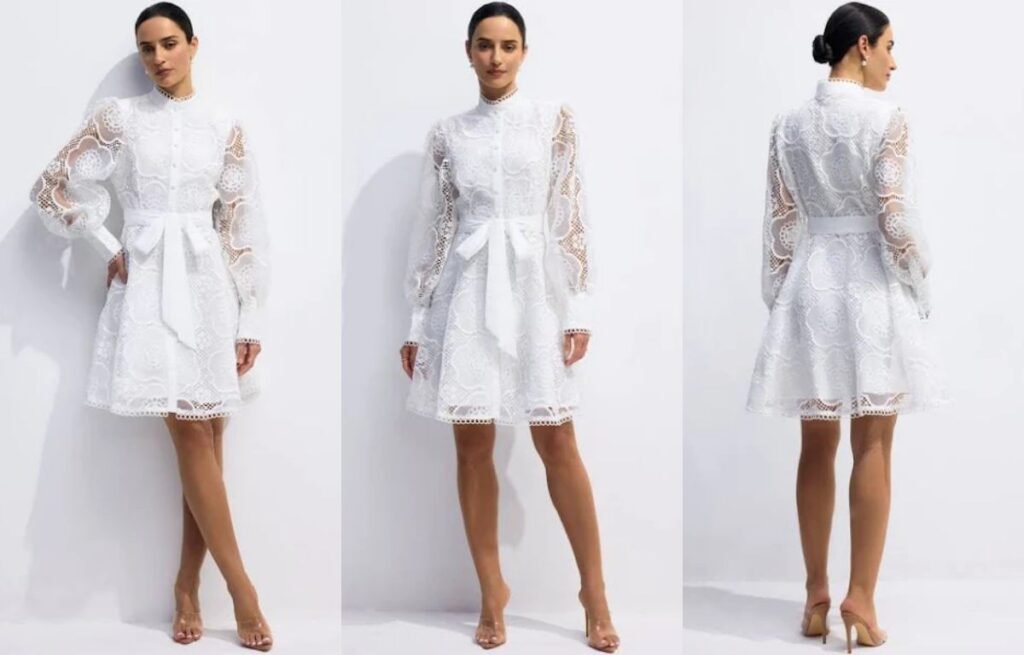
Lantern Sleeve: Voluminous, Romantic, and Full of Character
The lantern sleeve is known for its puffed volume and gathered shape that tapers at the cuff—creating a bold, graceful silhouette.
This sleeve is fuller from the shoulder to the elbow or wrist and cinched at the end, resembling a traditional lantern shape. It’s often used in romantic, vintage, or runway-inspired dresses.
What makes the lantern sleeve so visually powerful?
Lantern sleeves draw attention through volume and movement. They transform simple dresses into statement pieces.
With their exaggerated round shape, lantern sleeves add softness and structure at once. They can be used to balance silhouettes, soften sharp lines, or create a vintage flair.
The Design Logic and Styling Power of Lantern Sleeves
Volume Placement and Silhouette Impact
The distinct feature of lantern sleeves is where the volume sits. Unlike balloon sleeves that puff out at the top, lantern sleeves build their shape from the mid-arm downward, ending in a snug cuff.
This creates:
- A rounded silhouette that enhances upper body presence
- A contrast effect when paired with a slim-fitting bodice
- A sense of drama while still feeling wearable
Designers use them to shift visual weight upward, especially in A-line or sheath dresses. This balances proportions and gives more shape to narrow shoulders or slim arms.
Historical Inspiration and Modern Relevance
Lantern sleeves originated in historical European fashion, often seen in Renaissance and Victorian styles. But today’s versions are lighter and more wearable, made with airy fabrics and modern cuts.
Fashion houses now incorporate lantern sleeves into minimalist, modern looks—showing how historical elements can be updated for contemporary women.
Body Type Versatility
Lantern sleeves suit many body types when styled correctly:
- Pear-shaped figures: Add volume on top to balance wider hips.
- Inverted triangles: Choose a subtle lantern shape to soften strong shoulders.
- Straight builds: Create curves and visual interest without cling.
- Petite frames: Opt for shorter sleeves or lighter fabric to avoid overwhelming the body.
Styling for Day and Evening
Lantern sleeves can shift easily between day and night depending on fabric and cut:
- Daywear: Soft cotton or linen lantern sleeves with floral prints for a relaxed, feminine look.
- Evening wear: Satin or taffeta versions create a formal, dramatic impact.
- Office wear: Structured lantern sleeves on poplin or crepe can add interest to professional dresses.
Lantern vs. Similar Sleeve Types
| Sleeve Type | Key Shape | Volume Location | Best Use |
|---|---|---|---|
| Lantern Sleeve | Rounded, cinched at cuff | Mid to lower arm | Romantic, bold looks |
| Puff Sleeve | Full at shoulder | Upper arm | Feminine, youthful styles |
| Bishop Sleeve | Full length, flowing | From shoulder down | Elegant, vintage vibes |
| Balloon Sleeve | Wide, tapers to wrist | Upper to full arm | Statement fashion |
Best Fabrics for Lantern Sleeves
Fabric affects how the lantern shape holds and moves:
- Organza and Taffeta: Crisp, hold volume well
- Cotton Poplin: Structured but breathable for daily wear
- Silk or Satin: Elegant drape for evening looks
- Chiffon: Light and airy for soft, romantic styles
Balloon Sleeve dress
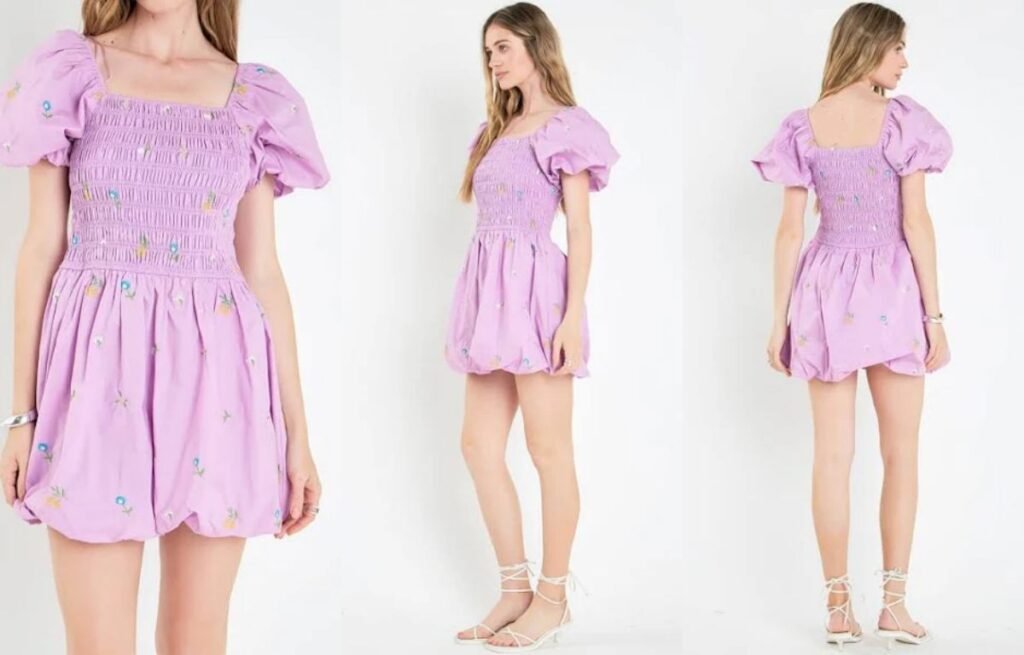
Balloon Sleeve: Voluminous, Romantic, and High-Impact
The balloon sleeve is known for its exaggerated shape, creating fullness at the upper or lower arm before cinching at the wrist or elbow.
This sleeve style brings instant drama to any dress, with its rounded, puffed shape that stands away from the body. It’s romantic, bold, and a key trend across runway and ready-to-wear collections.
Why are balloon sleeves so visually striking?
The balloon sleeve changes the proportion of a dress instantly.
Its voluminous shape adds boldness and character, while the tapered cuff brings balance, making it one of the most sculptural sleeve styles. It emphasizes movement, drama, and femininity in one simple design feature.
How Balloon Sleeves Enhance Design and Wearability
The Shape: More Than Just Puff
Balloon sleeves typically gather at the shoulder or armhole, then balloon out with fabric before being drawn back in at the cuff. The volume is usually created through pleats, gathers, or bias-cut fabric that expands outward.
This shape plays with negative space, making the wearer’s arms appear smaller and the waist more defined due to visual contrast.
Balloon sleeves are different from puff sleeves—they tend to be longer, rounder, and softer in silhouette, with more emphasis on length and flow than shoulder volume.
Balancing Volume and Structure
The key to making balloon sleeves work is balancing their dramatic volume with the rest of the outfit.
- On fitted dresses: Balloon sleeves add dimension to an otherwise sleek silhouette, offering contrast without overwhelming the body.
- On flowy dresses: They complement the softness and enhance the romantic vibe.
- On structured dresses: The sleeve adds modernity and editorial appeal, especially when paired with clean lines and bold fabrics.
Designers use balloon sleeves to direct attention upwards or soften the body’s outline, which makes them especially useful in dresses meant to stand out on their own.
Ideal Body Types and Styling Tips
Balloon sleeves work best when styled with awareness of proportion:
- Pear-shaped bodies: The sleeve balances wider hips by creating volume on the upper body.
- Rectangle shapes: Adds curves and breaks up straight lines.
- Petite figures: Best with slightly cropped balloon sleeves to avoid overwhelming the frame.
- Inverted triangles: Should choose softer balloon styles with minimal shoulder gathering to avoid adding bulk.
Styling Suggestions:
- Balance volume: Pair balloon-sleeve dresses with a cinched waist or slim-fitting bottoms if separate.
- Minimal accessories: Let the sleeves speak—avoid heavy jewelry near the shoulders.
- Footwear: Works well with ankle boots, strappy heels, or loafers depending on dress style.
Balloon Sleeve vs. Similar Sleeves
| Sleeve Style | Volume Location | Length Focus | Key Feature |
|---|---|---|---|
| Balloon Sleeve | Mid-arm to wrist | Full or 3/4 | Rounded, puffed, tapered |
| Puff Sleeve | Shoulder | Short to elbow | Structured, lifted look |
| Bishop Sleeve | Gradual throughout | Long | Loose with wide cuffs |
| Lantern Sleeve | Elbow area | 3/4 or long | Rounded, taper at cuffs |
Best Fabrics for Balloon Sleeves
Balloon sleeves need structure or drape, depending on the desired effect.
- Organza: Crisp and light, perfect for dramatic volume.
- Cotton poplin: Structured and wearable for everyday looks.
- Chiffon: Adds softness and flow for romantic styles.
- Taffeta or Silk: Great for formal or evening dresses.
- Jersey: For a more casual, relaxed look with subtle volume
Bell Sleeve dress
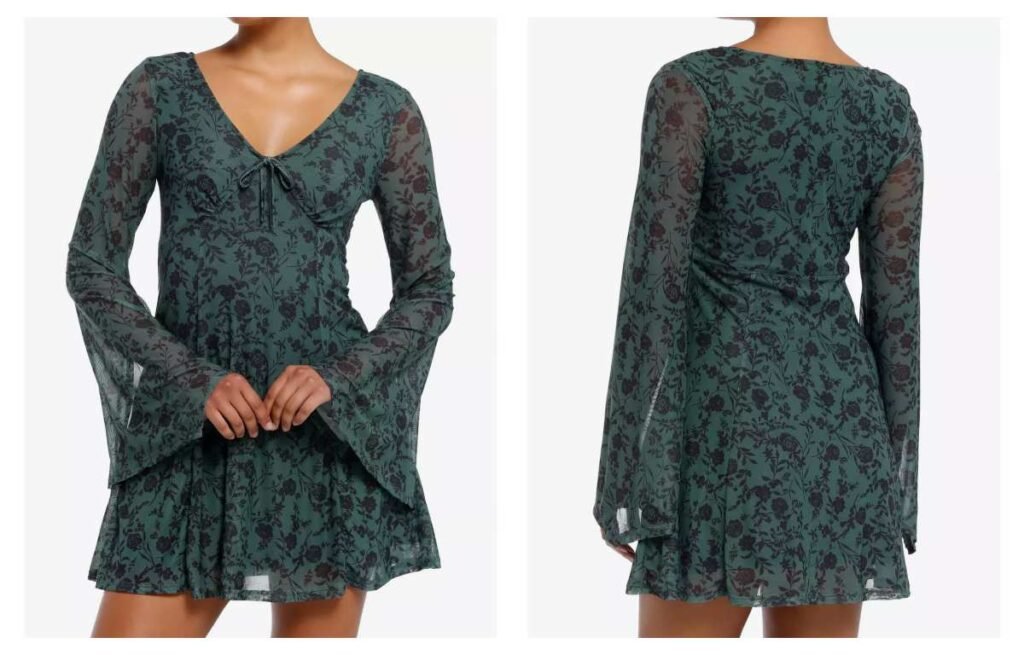
Bell Sleeve: The Feminine Flare That Adds Movement and Romance
The bell sleeve is instantly recognizable by its flared shape that widens from the shoulder or elbow to the wrist.
A bell sleeve adds volume and flow to a dress, creating a soft, romantic silhouette that moves gracefully with the wearer. It’s a detail that blends vintage charm with modern femininity.
Why is the bell sleeve such a timeless design?
Bell sleeves are dramatic without being overwhelming—and they flatter almost every body type.
The flare of the bell sleeve adds balance, elegance, and visual interest to even the simplest of dress silhouettes. It’s a go-to sleeve for adding a touch of drama without bulk.
The Structure, Appeal, and Versatility of Bell Sleeves
Historical Influence and Modern Comeback
Bell sleeves have a long history, dating back to medieval and Renaissance fashion. Over time, they’ve evolved from exaggerated court dress designs to wearable, stylish options in today’s fashion. They made a strong return in the 1970s during the bohemian wave and remain a key feature in festival, bridal, and romantic fashion.
Shaping the Silhouette
The beauty of bell sleeves lies in their ability to shape a garment’s overall look:
- Balance: For women with wider hips or pear-shaped bodies, bell sleeves create volume on the upper body, balancing proportions.
- Softness: The sleeve’s gradual flare creates a soft, flowing line that contrasts structured dresses.
- Length play: Bell sleeves can be short, elbow-length, or full-length, with each version offering a different mood—playful, elegant, or dramatic.
Variations in Cut and Style
Bell sleeves come in several key variations, each creating a unique effect:
| Style Variant | Description | Best Used In |
|---|---|---|
| Classic Bell Sleeve | Flare begins at the elbow or lower | Formal or vintage-style dresses |
| Trumpet Sleeve | More fitted through the arm, flaring near cuff | Sleek, modern looks |
| Layered Bell Sleeve | Multiple flared tiers for added drama | Occasion wear, fashion-forward |
| Split Bell Sleeve | Open slit along flare for added movement | Flowy summer or party dresses |
Fabric Choice Matters
Bell sleeves require a fabric that flows well without looking limp or too stiff. The fabric affects how much the flare moves, and how it holds shape:
- Best for fluid movement: Chiffon, rayon, crepe, silk
- Best for structure: Cotton blends, organza, taffeta
- For drama and volume: Layered lace, embroidered mesh
The right fabric gives the sleeve life—it swings when you walk, and creates an aura of effortlessness.
Styling Considerations
Because of their volume, bell sleeves should be the focal point of your outfit:
- Pair with fitted silhouettes: Dresses with cinched waists or body-skimming shapes balance out the sleeve drama.
- Keep accessories minimal: Let the sleeve do the talking.
- Perfect for layering: Works well under vests or cropped jackets with wide armholes.
Bell Sleeve vs. Other Flared Sleeves
| Sleeve Type | Flare Start Point | Shape | Mood/Style |
|---|---|---|---|
| Bell Sleeve | Elbow or wrist | Gradual, wide flare | Romantic, feminine |
| Flounce Sleeve | Near the cuff | Circular ruffle at the end | Playful, youthful |
| Bishop Sleeve | From shoulder, gathered at cuff | Full, soft balloon shape | Vintage, elegant |
Trumpet Sleeve dress
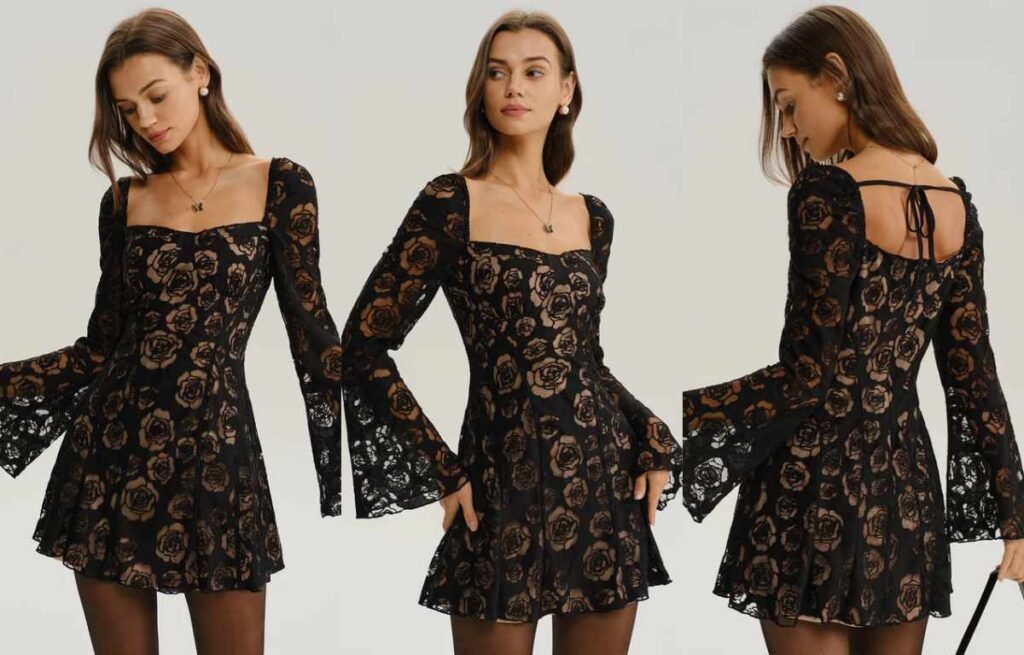
Trumpet Sleeve: Soft Drama with a Feminine Flare
The trumpet sleeve is a romantic and graceful style that adds subtle drama to any dress without overwhelming the look.
This sleeve is fitted through the upper arm and flares out near the elbow or wrist, resembling the bell of a trumpet. It blends elegance with movement, making it ideal for both casual and formal wear.
What makes the trumpet sleeve unique in dress design?
Unlike dramatic bell sleeves or basic flared styles, the trumpet sleeve offers a balanced silhouette.
It hugs the arm for a sleek upper fit, then softly flares out for graceful movement—creating a clean, flattering line that elongates the arms.
The Design Function and Fashion Role of Trumpet Sleeves
Controlled Volume and Proportion
The beauty of trumpet sleeves lies in their structure. While other flared sleeves start wide from the shoulder, trumpet sleeves keep the flare controlled. This creates a silhouette that adds visual interest without bulk.
- The fitted upper arm gives shape and a tailored feel.
- The flare starting near the elbow or forearm adds a sense of rhythm and softness as the wearer moves.
This balance is what makes trumpet sleeves versatile—they offer elegance without looking exaggerated.
Enhancing Body Lines
Trumpet sleeves elongate the arms and help balance the overall look of a dress. They work particularly well with:
- Hourglass and pear shapes, by drawing attention to the upper body
- Petite frames, by adding vertical length through the sleeve flare
- Tall figures, to soften long limbs with fluidity
The sleeve also enhances A-line and fit-and-flare dresses, reinforcing a romantic yet structured silhouette.
Fabric Behavior and Flow
Fabric choice determines how the trumpet shape performs:
- Lightweight chiffon or georgette creates a soft, floaty flare.
- Crepe or ponte knit holds a clean, more structured shape.
- Lace or sheer overlays add texture and layering without visual weight.
Designers often match trumpet sleeves with delicate necklines, such as sweetheart or scoop necks, to create a gentle, harmonious look.
Trumpet vs. Similar Sleeve Styles
| Sleeve Style | Fit at Arm | Flare Start Point | Visual Effect | Best Use Case |
|---|---|---|---|---|
| Trumpet Sleeve | Fitted to elbow | Elbow or forearm | Balanced, graceful | Weddings, office chic |
| Bell Sleeve | Loose from shoulder | Shoulder | Dramatic, bohemian | Festivals, statement wear |
| Flounce Sleeve | Tiered or gathered | Varies (upper arm or elbow) | Playful, romantic | Casual to dressy |
| Bishop Sleeve | Full with cuff | Full arm with wrist cuff | Regal, voluminous | Formalwear, gowns |
Best Fabrics for Trumpet Sleeves
- Chiffon: Airy and perfect for soft, fluttering movement
- Crepe: Holds shape with a fluid drape, ideal for minimal styles
- Lace: Adds texture and visual depth without heaviness
- Satin: For eveningwear with a soft sheen and structured flow
Styling Tips for Trumpet Sleeve Dresses
- Keep accessories minimal to let the sleeve shine.
- Choose fitted bodices or cinched waists to balance the flare.
- For colder seasons, layer under sleeveless dresses with trumpet sleeve tops for added texture.
Butterfly Sleeve dress
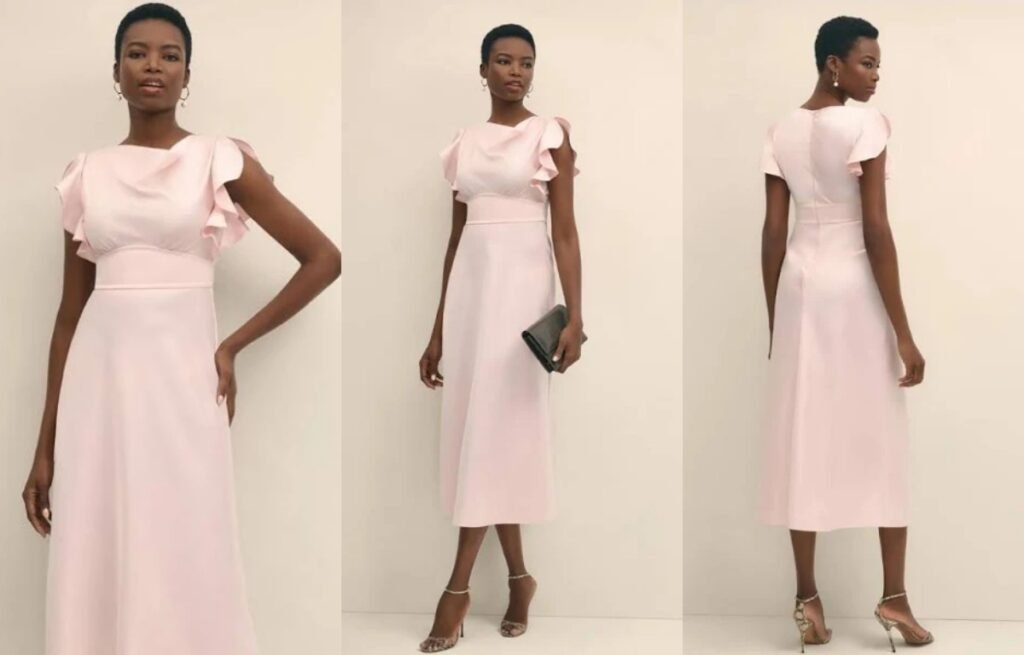
Butterfly Sleeve: Soft, Flowing, and Ultra-Feminine
The butterfly sleeve is known for its delicate, fluttery shape that drapes loosely over the upper arm, often extending outward in a wide, curved silhouette.
It creates a soft, romantic effect that’s ideal for dresses with a feminine or boho vibe. Lightweight and breezy, butterfly sleeves are especially popular in summer styles or event dresses where comfort and elegance are key.
What makes butterfly sleeves unique compared to other flowing sleeve styles?
Butterfly sleeves offer volume without weight, and structure without stiffness.
They differ from bell or flared sleeves by starting at the shoulder with little to no seam at the armhole, flowing outward freely like wings. This creates a more organic, floaty movement around the arms.
Why Butterfly Sleeves Are a Designer Favorite
The Illusion of Lightness and Movement
Butterfly sleeves mimic the flutter of butterfly wings—hence the name. Their design introduces a light, air-like movement, making them ideal for dresses meant to feel whimsical or soft.
Because they’re cut wide and loose from the shoulder, they allow the fabric to move freely with the body, often enhancing the drama of a flowing dress without being overbearing.
- Short butterfly sleeves add just a touch of volume.
- Longer versions can reach the elbow or wrist, mimicking a cape-like silhouette.
This movement makes them a strong visual element, even in simple dresses.
Comfortable and Forgiving Fit
Unlike fitted sleeves, butterfly sleeves don’t hug the upper arms. This makes them flattering for many body types—especially for those who prefer to keep the upper arms partially covered.
They also offer:
- Breathability in warm climates.
- Flexibility across sizes (great for size-inclusive designs).
- A softer alternative to puff or structured sleeves.
Styling Compatibility
Butterfly sleeves work beautifully with:
- Boho dresses: Printed rayon, flowing cuts, gathered waists.
- Formal gowns: When paired with chiffon or silk, butterfly sleeves add graceful drama to evening wear.
- Vintage-inspired styles: Think 1930s tea dresses or retro floral prints.
These sleeves also look stunning when layered with lace, embroidery, or beading—details that catch light and emphasize movement.
Butterfly Sleeves vs. Other Flowing Sleeves
| Sleeve Style | Shape | Fit | Movement | Best For |
|---|---|---|---|---|
| Butterfly Sleeve | Wide, wing-like | Loose | High | Boho, romantic, summer |
| Bell Sleeve | Flares out from elbow | Fitted to elbow | Moderate | Vintage, structured looks |
| Flounce Sleeve | Attached ruffle at hem | Fitted arm | Moderate | Feminine, modern chic |
| Cape Sleeve | Drapes from shoulder | No armhole seam | Flowing | Dramatic, formal wear |
Best Fabrics for Butterfly Sleeves
Fabric choice defines the flow and effect:
- Chiffon: Lightweight, sheer, and ultra-flowy—perfect for formal or dreamy styles.
- Georgette: Slightly textured with a soft drape.
- Silk or Satin: Luxurious options for evening wear.
- Rayon or Viscose: Breathable and ideal for casual summer dresses.
Avoid stiff fabrics—they reduce the sleeve’s fluttering effect.
Styling Tips for Butterfly Sleeve Dresses
- Balance the volume: Pair with a defined waist or slim-fitting skirt to avoid a boxy shape.
- Keep jewelry light: Dangly earrings or fine bracelets work well; bulky accessories can clash with the sleeve’s movement.
- Use minimal layering: Let the sleeve stand out—avoid jackets that restrict its shape.
Angel Sleeve dress
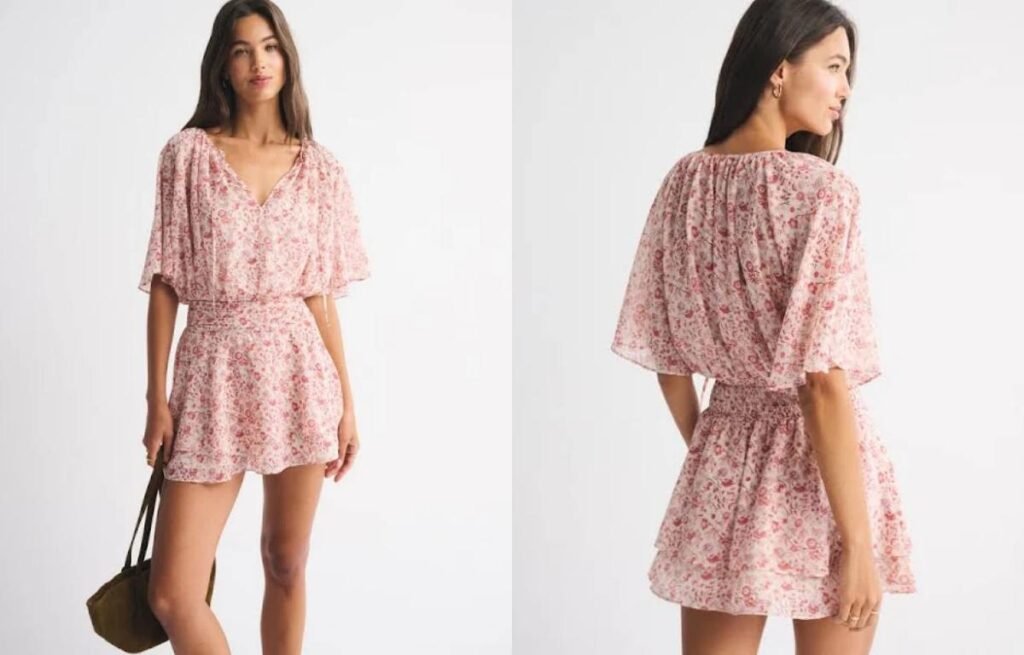
Angel Sleeve: Soft, Flowing, and Romantic
The angel sleeve is known for its gentle drape and airy movement, bringing a dreamy, ethereal touch to dresses.
Angel sleeves are long, wide, and flowy, often extending from the shoulder or slightly below, with a soft flare that floats away from the arm. They’re a popular choice for bohemian, romantic, or vintage-inspired styles.
What makes the angel sleeve so unique?
It’s all in the silhouette and softness. Angel sleeves are about flow, not form.
The loose, fluttering cut gives the arm freedom and movement while adding volume without weight. This design creates a graceful, almost floating effect that softens the overall look of a dress.
Why Angel Sleeves Work Across Styles and Seasons
Origins and Evolution
Angel sleeves have roots in medieval and renaissance garments where long, flowing sleeves signified grace and status. Today, they’ve evolved into a go-to choice for designers aiming to create soft silhouettes without heavy tailoring.
You’ll often see angel sleeves in:
- Boho dresses
- Beach wedding gowns
- Summer maxis
- Vintage revival collections
Their timeless, romantic shape has kept them in both couture and casual fashion across decades.
Design Impact on Silhouette
Unlike puff or fitted sleeves that add structure, angel sleeves extend the line of the arm, creating vertical movement. This gives the illusion of height and elongation. Because they’re unstructured, they don’t cling or add bulk.
Angel sleeves are especially flattering for:
- Broad shoulders: Softens width without exaggeration
- Full arms: Adds coverage while keeping things breezy
- Petite frames: Creates length without weight
Fabric Matters
Angel sleeves rely on movement, so the fabric must be fluid:
- Chiffon: Lightweight, sheer, and ideal for floating sleeves
- Silk or georgette: Offers drape with a luxurious feel
- Lace: Perfect for romantic or bridal styles
- Rayon or modal: Great for everyday versions of the angel sleeve
Fabrics that are too stiff or heavy (like denim or canvas) lose the flow that defines this sleeve.
Styling Angel Sleeves
Despite their softness, angel sleeves can work across different style categories:
- Bohemian: Pair with embroidery, floral prints, and flowy skirts
- Romantic: Match with ruffles, lace trims, and pastel tones
- Minimalist: Go for solid neutrals and let the sleeve shape stand out
- Bridal: Combine with low backs, empire waists, or sheer bodices
Angel Sleeve vs. Similar Styles
| Sleeve Style | Shape & Movement | Fit | Vibe |
|---|---|---|---|
| Angel Sleeve | Long, soft, flowing | Loose | Romantic, ethereal |
| Bell Sleeve | Flares from elbow or wrist | Semi-fitted | Dramatic, retro |
| Flutter Sleeve | Short, soft, flared | Loose | Feminine, playful |
| Bishop Sleeve | Fitted at wrist, puffy top | Structured | Vintage, elegant |
When to Wear Angel Sleeves?
Angel sleeves are seasonally versatile, depending on fabric weight:
- Spring/Summer: Pair lightweight versions with sandals or espadrilles
- Fall: Layer under sleeveless coats or vests
- Occasions: Great for outdoor weddings, festivals, beach events, or casual brunches
Juliet Sleeve dress
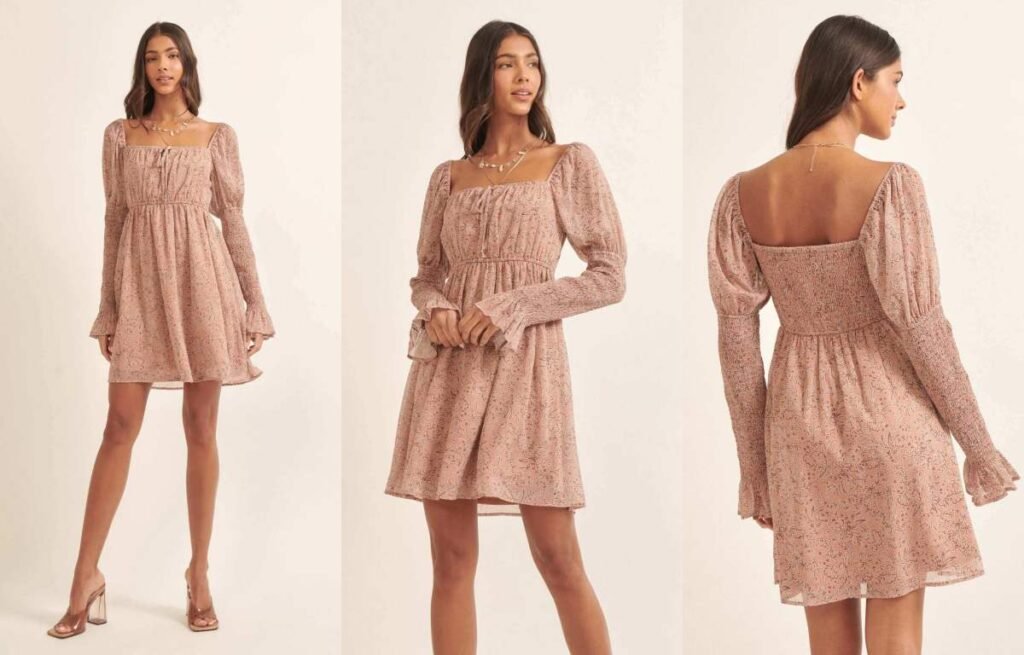
Juliet Sleeve: Romantic Volume with a Structured Touch
The Juliet sleeve brings classic drama to modern fashion. With its signature puffed upper arm and long fitted lower sleeve, it instantly adds romance and elegance to any dress.
This sleeve starts with gathered fullness at the shoulder and narrows down along the arm, creating a balanced, graceful silhouette. It’s named after Shakespeare’s Juliet and often appears in vintage-inspired or formal dresses.
Why is the Juliet sleeve so timeless?
Juliet sleeves evoke a sense of vintage beauty while offering structural interest.
The mix of volume and taper gives it a unique shape—eye-catching yet refined. It highlights the shoulders, flatters the arms, and works beautifully in both classic and contemporary styles.
Exploring the Allure of the Juliet Sleeve
Design Structure: A Study in Contrast
The Juliet sleeve is built around contrast:
- Puffed upper sleeve: Often gathered at the shoulder with pleats or elastic, it adds visual volume.
- Fitted forearm: The lower part is sleek and tailored, often ending at the wrist or elbow with a cuff or buttoned finish.
This structure creates balance—adding drama without overwhelming the overall silhouette. The sleeve enhances movement and posture while drawing the eye upward.
Visual Impact on Body Proportions
Juliet sleeves can visually reshape the upper body:
- Accentuate narrow shoulders by adding volume at the top.
- Balance wider hips by drawing the eye to the upper body.
- Lengthen the arms through a fitted lower sleeve, especially when styled with vertical seam lines or covered buttons.
This makes it a great choice for pear-shaped or hourglass figures wanting to highlight their upper half.
Styling Range and Fashion Versatility
Juliet sleeves are surprisingly versatile:
- Formal gowns: Often seen in bridal and eveningwear, adding a soft, regal flair.
- Boho or cottagecore dresses: Made with cotton, lace, or chiffon, these sleeves add vintage charm.
- Modern minimal styles: In solid colors and clean cuts, the sleeve becomes an elegant focal point without extra detailing.
They also work well across seasons:
- In cooler months, they add warmth and coverage with long sleeves.
- In warmer weather, the puffed upper sleeve gives breathability while maintaining style.
Juliet vs. Other Puff-Inspired Sleeves
| Sleeve Style | Upper Arm Detail | Lower Arm Fit | Overall Impression |
|---|---|---|---|
| Juliet Sleeve | Puffed, gathered | Fitted, structured | Romantic, vintage |
| Bishop Sleeve | Loose all the way | Cinched at wrist | Flowing, soft |
| Leg-of-Mutton | Extremely full at top | Tapers sharply | Dramatic, bold |
| Lantern Sleeve | Bell-shaped volume | Loose below elbow | Playful, statement |
Best Fabrics for Juliet Sleeves
- Chiffon, tulle, and organza: Enhance the puffed structure while staying lightweight.
- Cotton poplin or voile: Great for casual or daytime versions with a soft silhouette.
- Satin, silk, or crepe: Ideal for formal and bridal styles.
- Lace: Adds texture and a vintage effect.
Styling Tips
- Pair Juliet sleeves with minimalist accessories to let the sleeve shine.
- For a balanced look, go with a fitted bodice or high waistline to offset the sleeve volume.
- Avoid oversized jewelry on the wrists—let the fitted lower sleeve remain clean and elegant.
Poet Sleeve dress
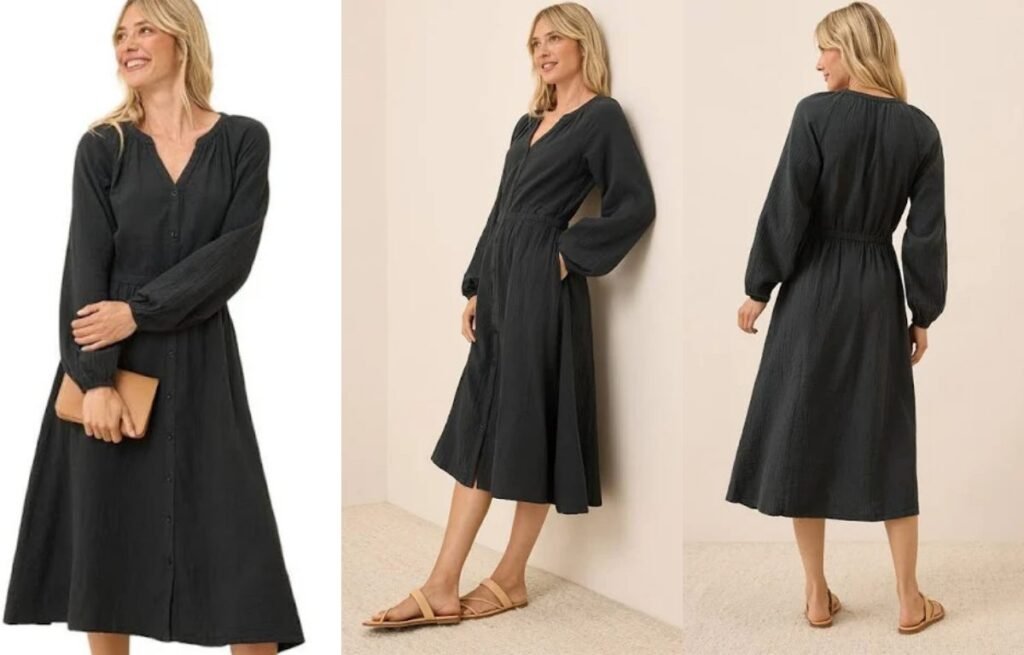
Poet Sleeve: Romantic Volume with Soft Drama
The poet sleeve brings elegance and vintage flair to any dress. Flowing and gathered, it adds instant romance.
Poet sleeves are long, full sleeves that gather into a cuff at the wrist—often with ruffles or elastic to enhance the softness and shape. They draw inspiration from 18th and 19th-century literature and fashion, giving modern garments a whimsical, dreamy silhouette.
Why does the poet sleeve keep returning to fashion?
It offers a soft yet striking contrast to sharp lines and structured cuts.
Poet sleeves add volume and movement to the arms, giving dresses a touch of drama while keeping the overall mood soft and wearable. They work across many dress styles—from bohemian maxis to polished midis.
Understanding the Design Impact of Poet Sleeves
Historical Roots with Modern Appeal
Poet sleeves have roots in historical fashion—worn by artists, writers, and aristocrats. Their revival in modern fashion taps into nostalgia while adding softness to contemporary cuts. They’re often seen in vintage-inspired pieces, cottagecore looks, and romantic eveningwear.
The poetic name is no accident—this sleeve is about storytelling, movement, and a sense of artistic identity.
Shape and Movement
Poet sleeves are designed with extra fabric volume, usually gathered at the shoulder and wrist. This creates a flowy drape with a defined wrist finish. As the wearer moves, the sleeve sways gently, adding an element of softness and fluidity to the overall dress.
Designers use this sleeve to:
- Break up fitted bodices with volume
- Add lightness to heavier fabrics
- Create contrast in minimalist silhouettes
Fabric Choice is Key
Because of the volume, fabric selection is critical. Lightweight materials allow the sleeve to drape and flow naturally, while stiffer fabrics may create too much bulk.
Ideal fabrics for poet sleeves include:
- Chiffon: Light and airy, perfect for ethereal looks
- Rayon: Flowy and breathable, drapes well
- Silk blends: Elegant sheen with soft structure
- Cotton voile: Crisp but still lightweight for casual styling
Body Type Compatibility
Poet sleeves can work for most figures but need balance:
- Petite frames: Opt for less dramatic volume to avoid overwhelming the body.
- Broad shoulders: The sleeve can soften the upper body visually.
- Curvy bodies: Balance the sleeve with a defined waist to keep the shape proportionate.
Styling Considerations
- Romantic Looks: Pair with lace or floral dresses for a vintage feel.
- Structured Dresses: Add a poet sleeve to soften otherwise clean lines.
- Modern Boho: Combine with flowing maxi dresses, leather belts, and boots.
- Evening Wear: Use silk poet sleeves for a soft but elegant alternative to puff sleeves.
Poet Sleeve vs. Other Long Sleeves
| Sleeve Style | Key Feature | Vibe | Best For |
|---|---|---|---|
| Poet Sleeve | Flowing, gathered at wrist | Romantic, vintage | Boho, dressy, layered |
| Bishop Sleeve | Volume at wrist, tapered | Dramatic, elegant | Formal looks |
| Bell Sleeve | Flare from elbow | Retro, playful | 70s-inspired styles |
| Fitted Long Sleeve | Slim, full length | Clean, minimal | Everyday or layering |


